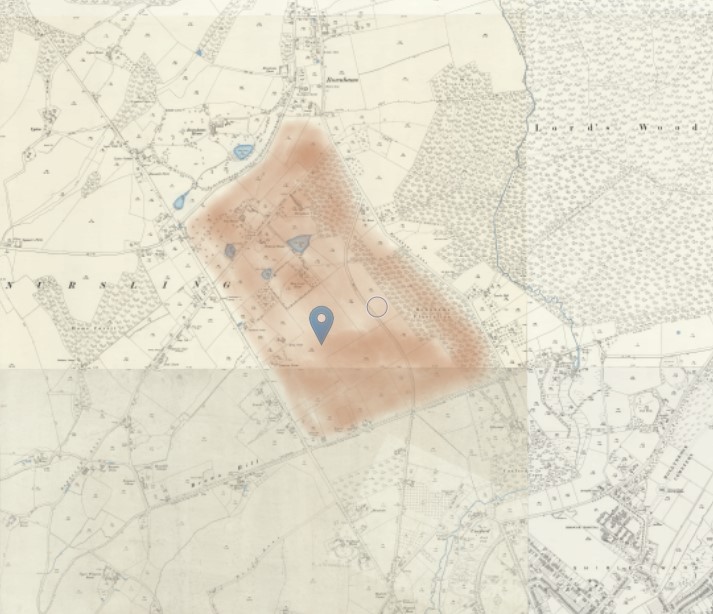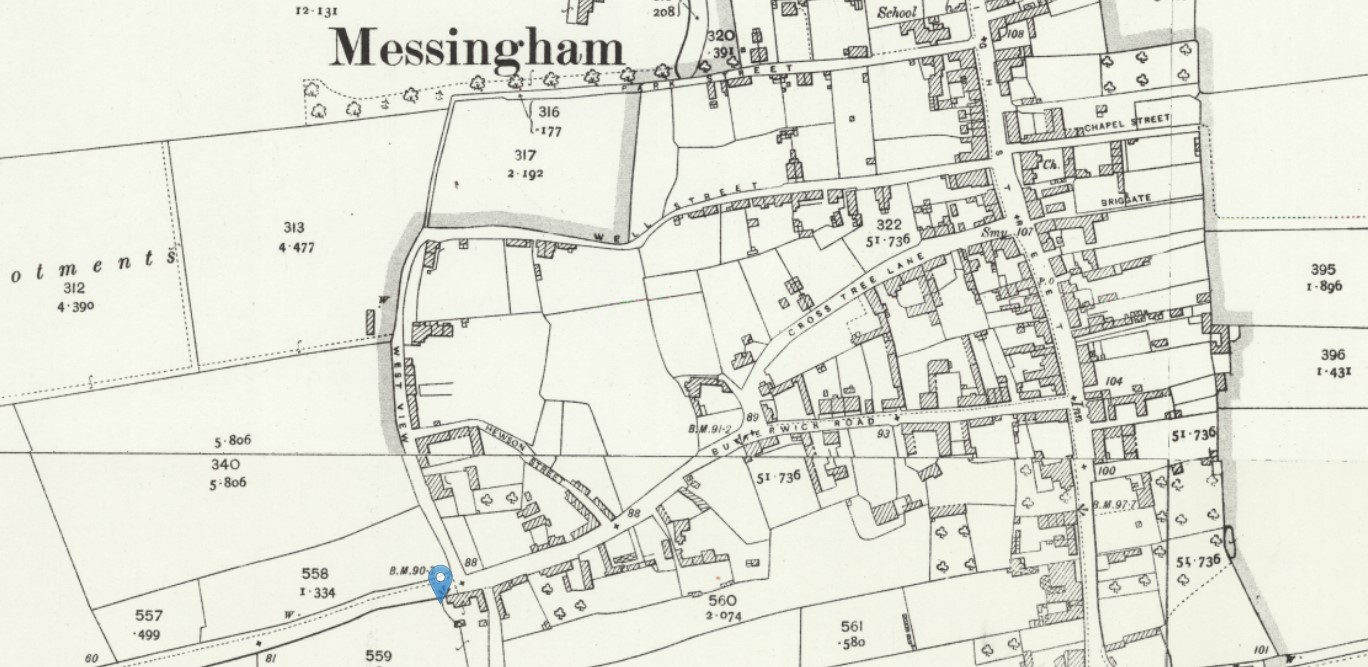The Camp on Nursling Common, Hampshire - 1795
The Camp
In the Parish Register for Nursling, there are several references to 'the Camp' or 'from the Camp', without any clear explanation of where or what the Camp was. From context it is assumed to be a place.
The Camp, why
I have yet to find any clear reason for the Camp, but looking at the history of the time may provide some insight.
The French Revolution (1789–1799) and the French Revolutionary Wars (1792–1802) caused considerably disquiet in the politics of Britain at the time.
Armies were raised in preparation, for defense against invasion by France.
See British Regiments and the Men Who Led Them 1793-1815: the "Ephemeral Corps" 1793-1796
I assume there was a massing of families associated with those regiments within Hampshire and other Counties along the South Coast.
The Camp, evidence
This is evident in the sudden increase in baptisms and burials found in the Parish Register for Nursling.
The records refer to 'from the Camp' but don't explicitly state if that is Toot Hill Camp or some other area.
The Camp seems to have been set up sometime shortly before August 1795.
{There is a surprise towards the end}
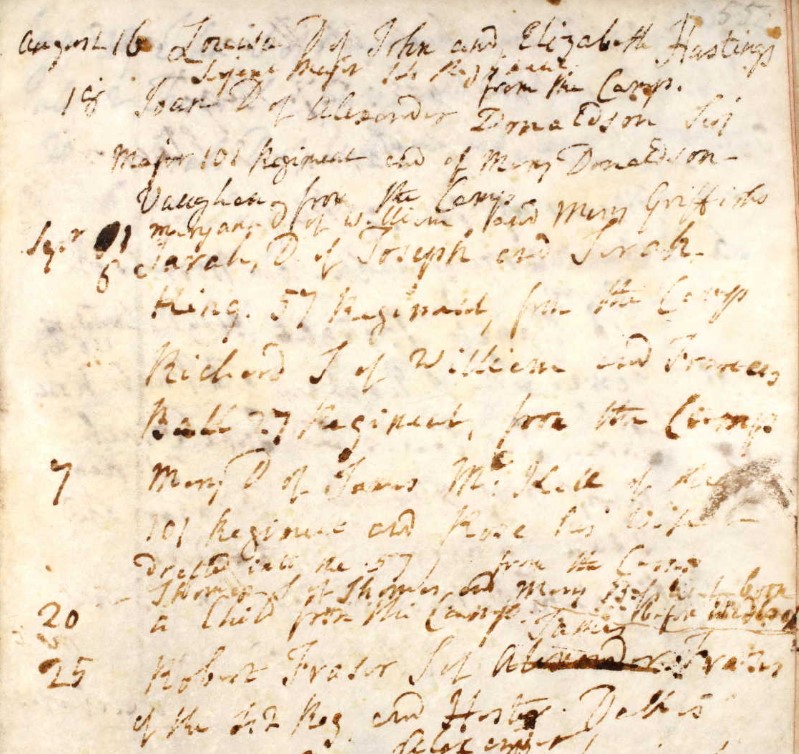
August 16 Louisa D of John and Elizabeth Hastings
18 Joan D of Alexander Donaldson Sargent Major 101 Regiment and of Mary Dodaldson-Vaughan from the Camp
Sepr 1 Maryann D of William and Mary Griffiths
6 Sarah, D of Joseph and Sarah King, 57 Regiment, from the Camp
Richard, S of William and Frances Ball 27 Regiment, from the Camp
7 Mary D of James McKell of Kings 101 Regiment and Rose his Wife - ??? the 57 , from the Camp
etc.
Two locals and four from the Camp, just in this part of the page. Before the writing becomes difficult to decipher.

The same information as the Parish Register, but this is from the Bishop's Transcript, which in this instance is easier to read.
As a matter of note I have taken the information about Joan Donaldson and her baptism on 18th August 1795, and created a mini tree, in my Ancestry Research Tree. Using that tree I have searched for more information about her Sargent Major father within Military Records. Unfortunately, I did not get any closer to definitively finding the location of the Camp referred to in the Register.
A similar exercise for Louise Hastings, also on the 18th August 1795, and whose father is also a Sargent Major, but 14th Regiment, also failed.
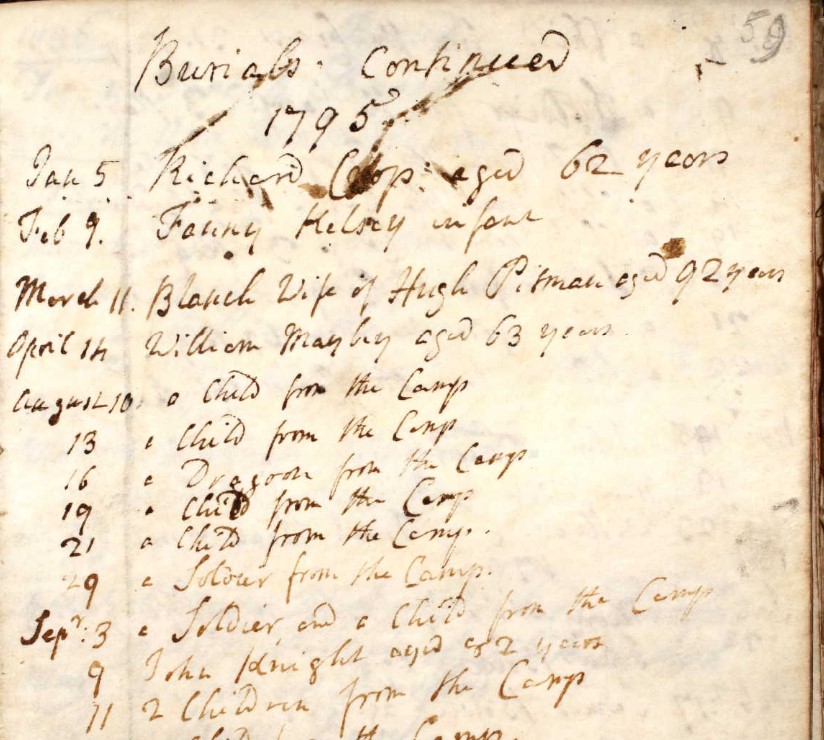
At least with the baptisms from the Camp, there were names. With these burials the records are 'a child from the Camp', 'a Dragoon from the Camp', 'a Soldier from the Camp', 'a Soldier and a Child from the Camp', '2 Children from the Camp'. I am guessing that all of these are in unmarked graves.
It is amazing to me that there are so many different regiments referred to in this camp. I wonder if it is some sort of hospital or recovery camp.
The Camp, location
At last, amongst the Marriage Records, a location for the Camp.
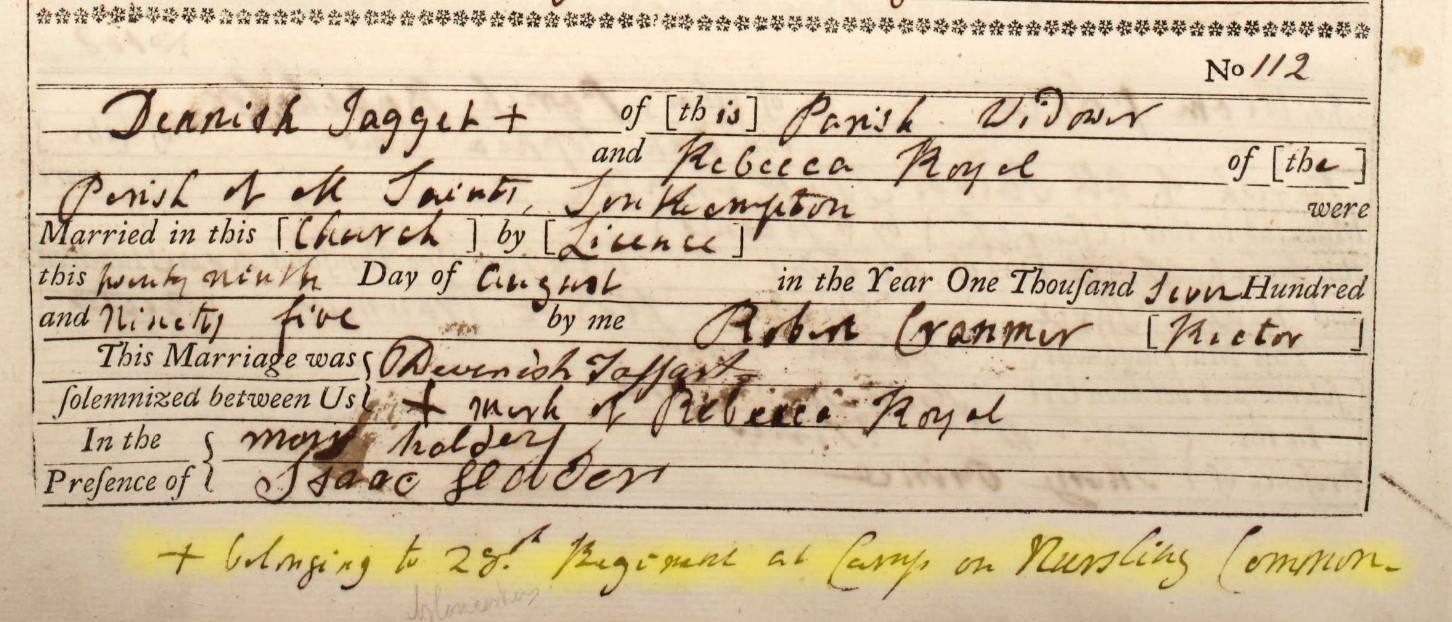
Marriage of Devenish Jagget and Rebecca Royal on 29 August 1795. However, the significant part for us is + belonging to 28th Regiment at Camp on Nursling Common.
The Camp is on Nursling Common. This reinforces the temporary nature of the Camp.
Nursling or Nutshalling Common is shown on Milne's Hampshire 1791 map.
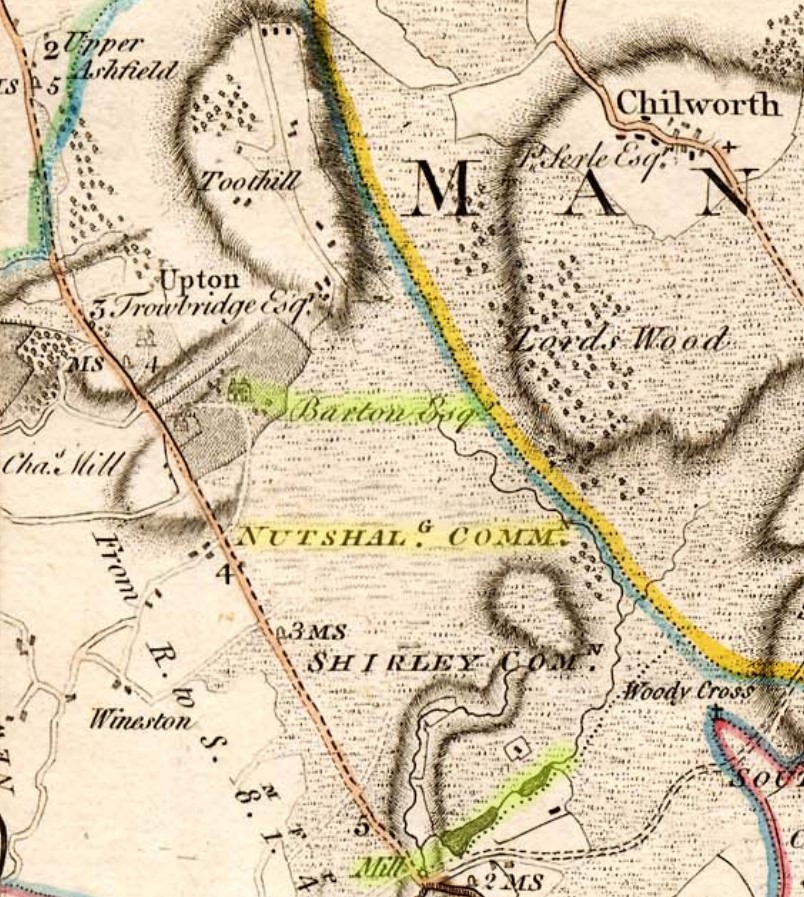
Also highlighted on the above extract are the House of Barton Esq and the Mill and ponds at the bottom of the image.
From a fascinating article about The Country Houses of Southampton, which includes Rownhams House.
Rownhams House, a mid-eighteenth century red brick building set in a park of 39 acres, was greatly enlarged around 1800 by the Barton family: the brick facade of the stables was of an unusual design.
The location on the map and the above text link Rownhams House and the Barton Esq highlighted on the map.
The Mill and ponds are at the junction of Romsey Road and Old Shirley Hill / Winchester Road, by the Tanners Brook. The Mill is called Shirley Mill located at the confluence of the Hollybrook and Tanner's Brook streams, which power it. Shirley Mill had three large ponds on the Holly Brook, to the side of Winchester Road, two of which are shown on the below map. One pond, the middle one, still exists.
Both Nursling and Shirley Commons are between these two know places.
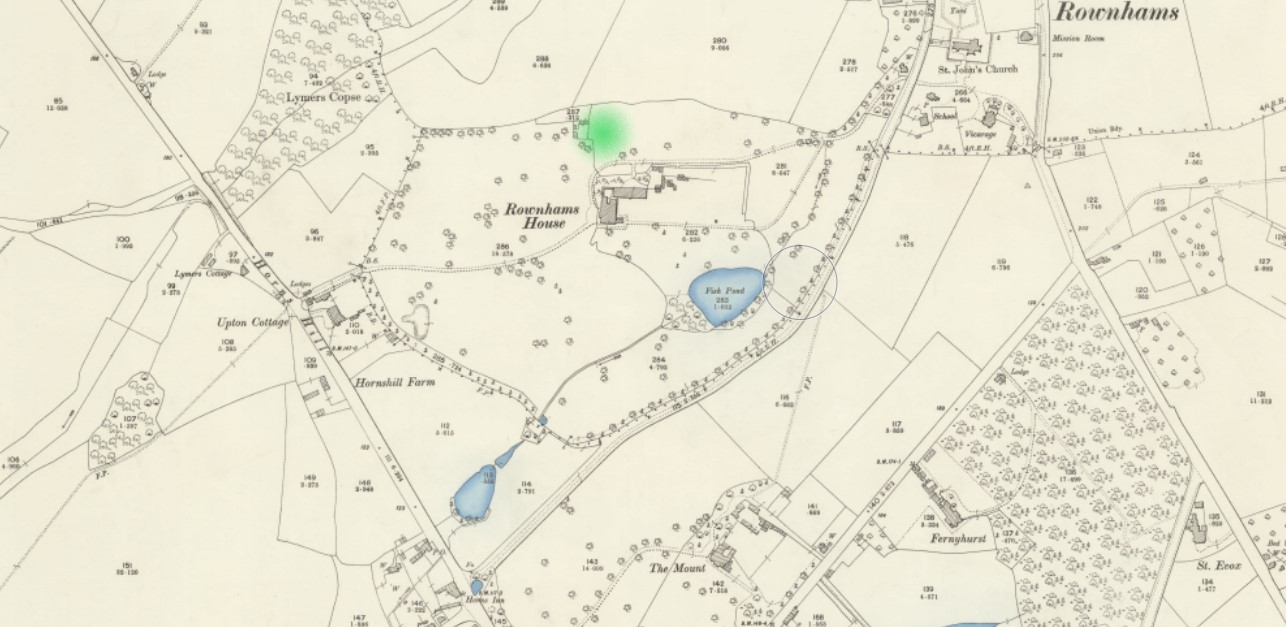
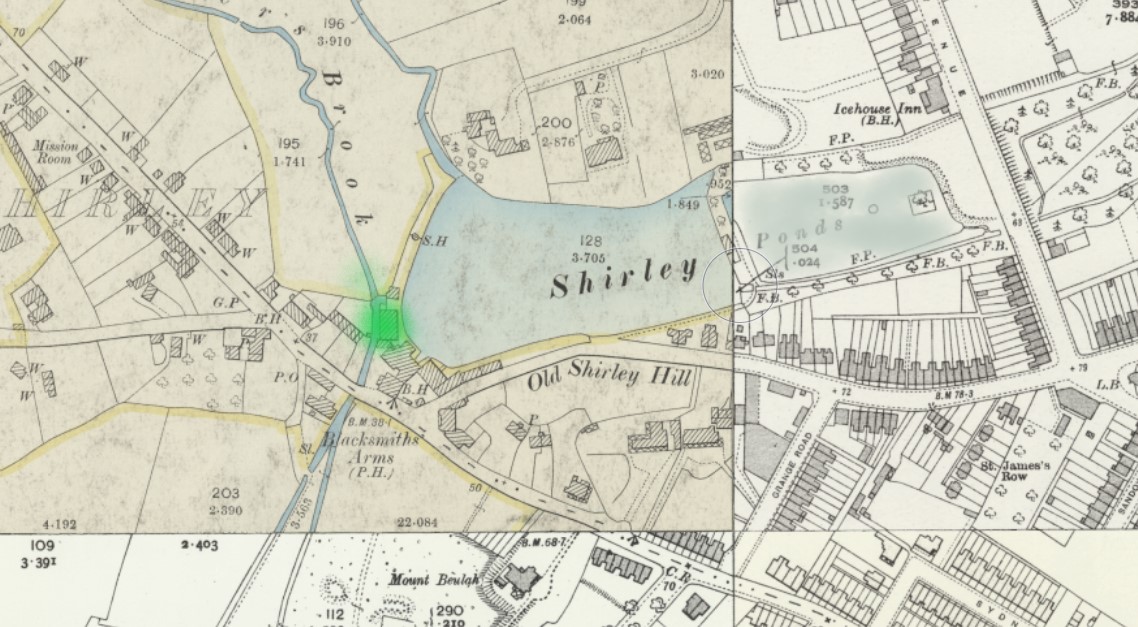
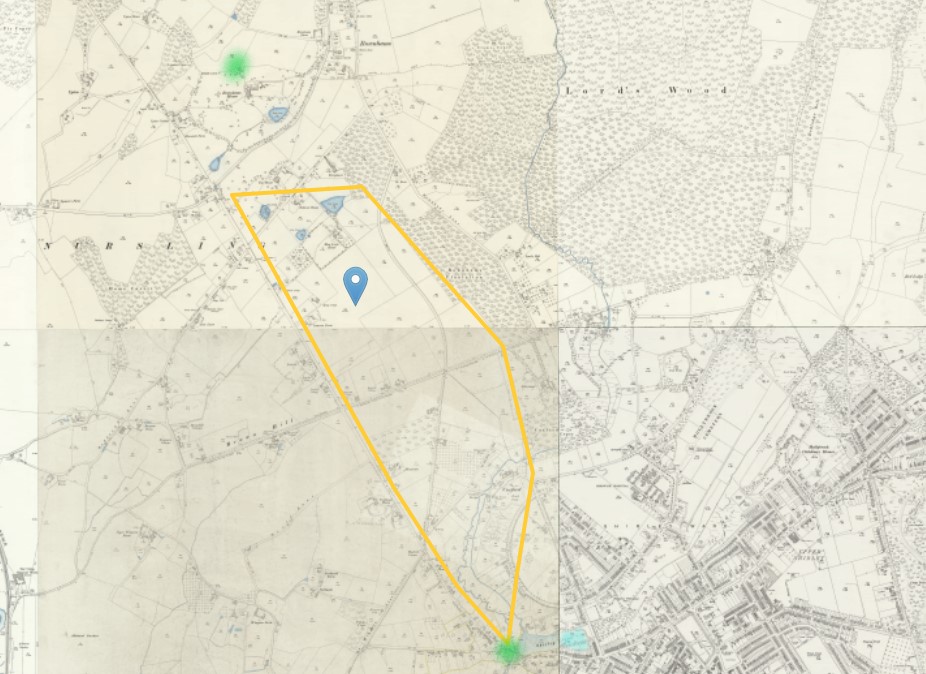
All three above maps are based on the Ordinance Survey 25" Old Maps from the National Library of Scotland.
The approximate location of Nursling or Nutshalling Common together with Shirley Common are bounded by the yellow line. In fact, Shirley Common extends further south than shown on this map.
Nursling Common is in the area of the marker on the above map.
Tithe Apportionment - Nursling - 1846
Looking at the Tithe Apportionment Map of Nursling dated 1846.
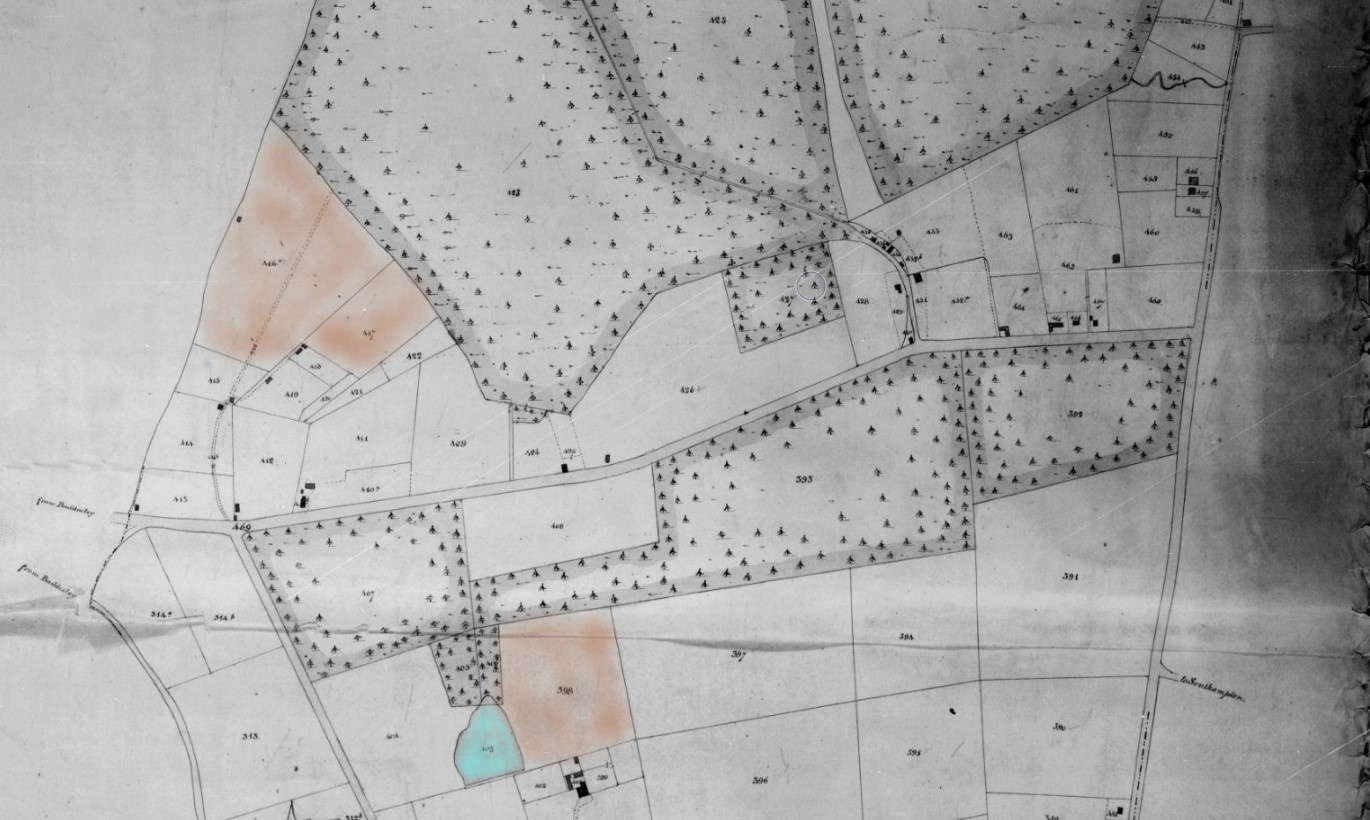
The plots described as common in the Tithe Apportionment are washed brown. However, they are not at this time actually Common.
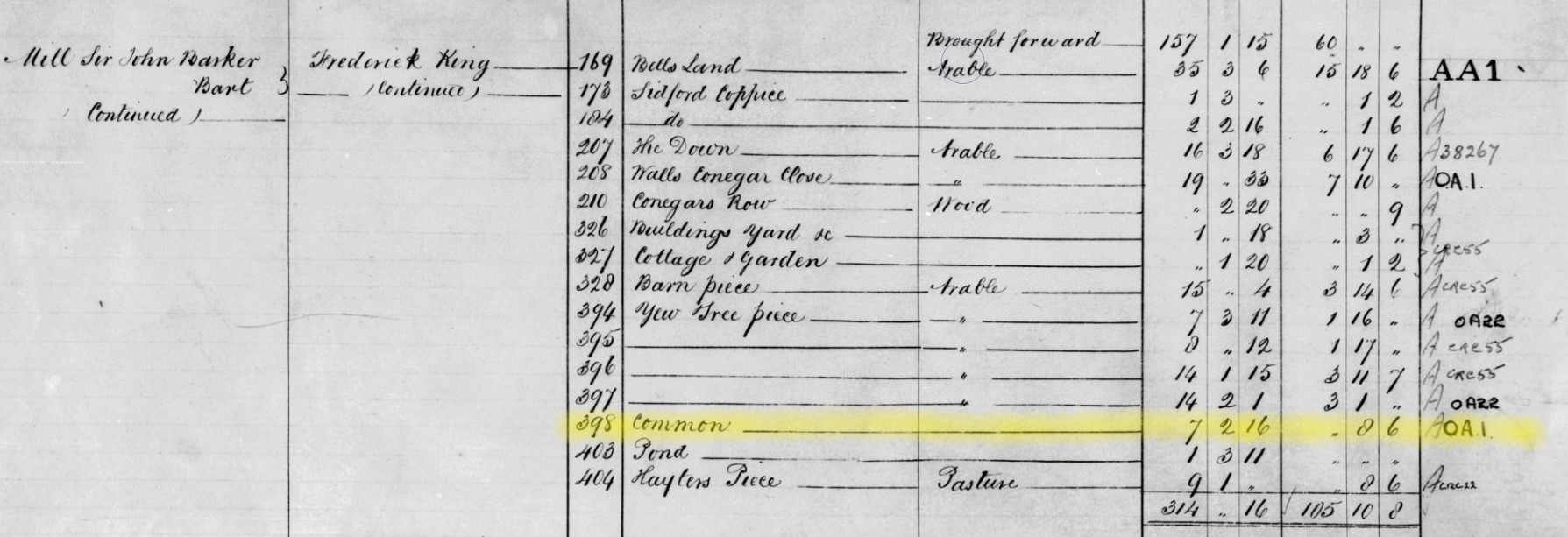
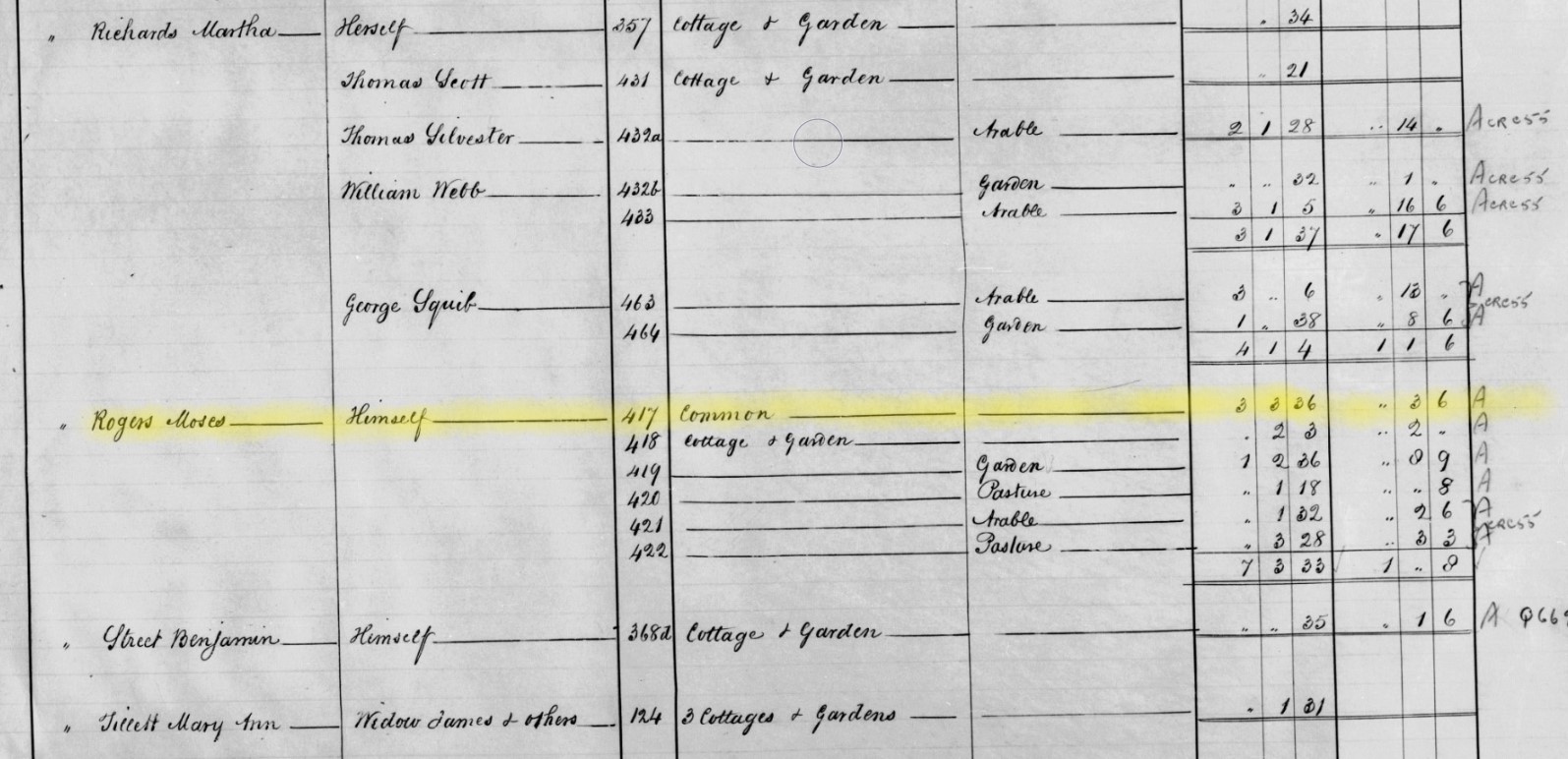
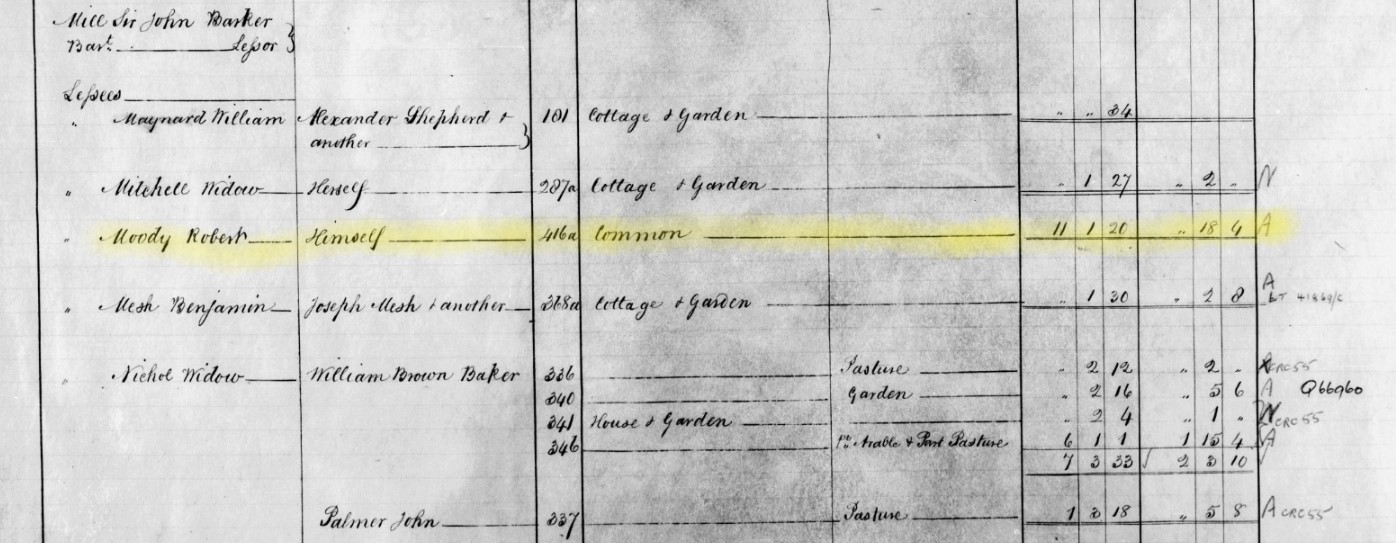
The fields are described as common but they are occupied and have a Tithe Apportionment allocated to them.
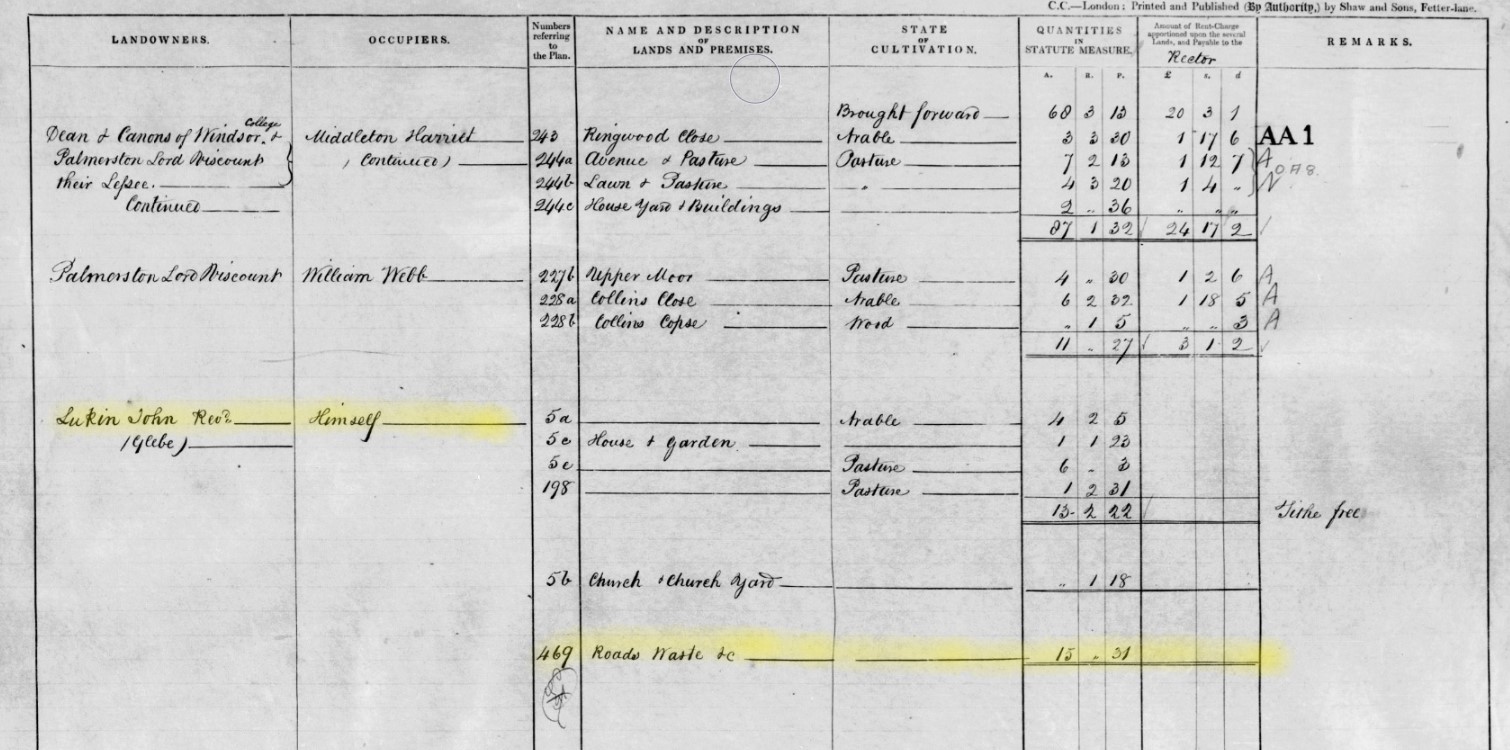
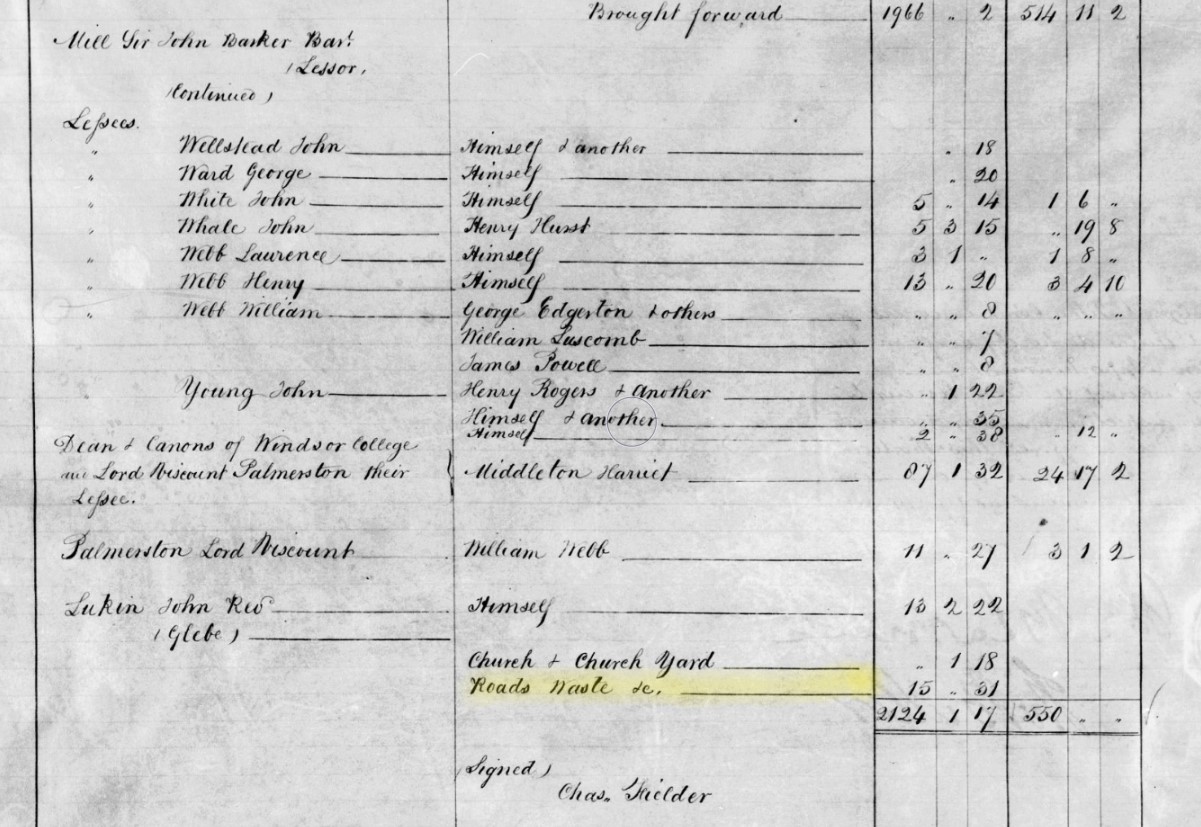
Common Land is sometimes called Waste on Tithe Apportionment. It can be seen that there is a reference to Roads, Waste etc. However, checking the Tithe Map for plot 469 I found several items, but the were all roads. None were expanses of 'waste'.
However, searching the Hampshire Records Office catalogue, I found this title;-
Agreement for the enclosure of the common fields, the demesne lands and glebe lands of Nursling and Millbrook dated 19 Jul 1756. The Tithe Apportionment Map was dated 90 years later so perhaps no surprise that there is so little evidence of the Common Lands, to be found in the Tithe Apportionment.
Hampshire Records Office also has details about leases regarding lands late of Nursling Common.
Together these might provide enough detail to firmly establish the location and extent of Nursling Common. However, until that time I will continue with the below approximation.
The Camp, data.
Baptisms
| Name | Gender | Baptism Date | Baptism Place | Father | Mother | Father's Rank | Regiment | Note |
|---|---|---|---|---|---|---|---|---|
| Louisa Hastings | Female | 16 Aug 1795 | Nursling | John Hastings | Elizabeth Hastings | Sergeant Major | ?? | from the Camp |
| Joan Donaldson | Female | 18 Aug 1795 | Nursling | Alexander Donaldson | Mary Donaldson-Vaughan | Sergeant Major | 101 | from the Camp |
| Sarah King | Female | 6 Sep 1795 | Nursling | Joseph King | Sarah King | --- | 57 | from the Camp |
| Richard Ball | Male | 6 Sep 1795 | Nursling | William Ball | Frances Ball | 27 | from the Camp | |
| Mary McKell | Female | 7 Sep 1795 | Nursling | James McKell | Rose McKell | King's 101 | from the Camp | |
| Thomas Boss | Male | 20 Sep 1795 | Nursling | Thomas Boss | Mary Boss | Drafted into 57 | a child from the Camp | |
| Robert Fraser | Male | 25 Sep 1795 | Nursling | Alexander Fraser | Hester ??? | 102 | ||
| Catherine Maclanring | Female | 25 Sep 1795 | Nursling | Alexander Maclanring | Belle Makay | Light ?? | ||
| John Campbell | Male | 27 Sep 1795 | Nursling | John Campbell | Janet Campbell-McKenon | Highlanders | ||
| William Harwood | Male | 29 Sep 1795 | Nursling | William Harwood | Ann Harwood | 27 | ||
| James Mears | Male | 2 Oct 1795 | Nursling | James Mears | Eleanor Mears | 19 | ||
| Mary Morrison | Female | 5 Oct 1795 | Nursling | William Morrison | Janet Bright | Highlanders 118 | ||
| Thomas Finch | Male | 15 Oct 1795 | Nursling | Charles Finch | Jane Finch | 31 | ||
| Mary Fraser | Female | 20 Oct 1795 | Nursling | Alexander Fraser | Jane Janeron | Highlanders |
Not all are annotated 'from the Camp' but I put that down to the scribe not wishing to continuously repeat, and waste precious paper.
Some of the writing is not very clear so some of the transcribing is a little questionable.
First entry 16th Aug 1795 and last entry 20th Oct 1795.
Fourteen Baptisms, seven boys and seven girls, in 66 days, or just over nine weeks.
Burials
| Name | Gender | Burial Date | Burial Place | Father | Mother | Father's Rank | Regiment | Note |
|---|---|---|---|---|---|---|---|---|
| A Child from the Camp | 10 Aug 1795 | Nursling | ||||||
| A Child from the Camp | 13 Aug 1795 | Nursling | ||||||
| A Dragoon from the Camp | Male | 16 Aug 1795 | Nursling | |||||
| A Child from the Camp | 19 Aug 1795 | Nursling | ||||||
| A Child from the Camp | 21 Aug 1795 | Nursling | ||||||
| A Soldier from the Camp | Male | 29 Aug 1795 | Nursling | |||||
| A Soldier and a Child from the Camp | 3 Sep 1795 | Nursling | ||||||
| 2 Children from the Camp | 11 Sep 1795 | Nursling | ||||||
| A Child from the Camp | 14 Sep 1795 | Nursling | ||||||
| A Soldier from the Camp | 22 Sep 1795 | Nursling | 90 | |||||
| A Soldier from the Camp | 26 Sep 1795 | Nursling | ||||||
| A Child from the Camp | 27 Sep 1795 | Nursling | ||||||
| A Child from the Camp | 1 Oct 1795 | Nursling | Highlander | |||||
| A Child from the Camp | 5 Oct 1795 | Nursling | 3 | |||||
| A Child from the Camp | 8 Oct 1795 | Nursling | 34 | |||||
| A Soldier from the Camp | 9 Oct 1795 | Nursling | 3 | |||||
| A Child from the Camp | 11 Oct 1795 | Nursling | ?? | |||||
| A Child from the Camp | 14 Oct 1795 | Nursling | Highlanders | |||||
| A Child from the Camp | 19 Oct 1795 | Nursling | 3 | |||||
| A Soldier from the Camp | 20 Oct 1795 | Nursling | Highlanders | |||||
| A Child from the Camp | 21 Oct 1795 | Nursling | 63 | |||||
| A Soldier from the Camp | 22 Oct 1795 | Nursling | 31 |
The writing was easier to read for this section, however, there is a distinct lack of names.
First entry 10th Aug 1795 and last entry 22nd Oct 1795.
That is 24 people buried in a duration of 74 days, or 10 1/2 weeks. More buried than baptised. Of the 24, eight were adults, and 16 were children.
Marriages
| Groom's Name | Bride's Name | Marriage Date | Marriage Place | His parish | His status | Her parish | Her Status | Rank | Regiment | Note | Type | |
|---|---|---|---|---|---|---|---|---|---|---|---|---|
| Dennish Tagget | Rebecca Royel | 29 Aug 1795 | Nursling | Nursling | Widower | All Saints, Southampton | 28 | belonging to 28th Regiment at Camp on Nursling Common | Licence | |||
| Mark Moring | Frances Kelly | 14 Sep 1795 | Nursling | Nursling | Bachelor | Nursling | Spinster | 14 | of the 14 Reg. | Banns | Y | |
| James Mallen | Esther Cannon | 4 Sep 1795 | Nursling | Nursling | Bachelor | Nursling | Widow | Sergeant | 14 | Sergeant of the 14 Regiment | Banns | Y |
| Robert McPheen | Catherine Prior | 19 Sep 1795 | Nursling | Nursling | Bachelor | Nursling | Widow | 19 | of the 19th Reg. | Licence | ||
| Daniel Elmer | Sarah Syle | 21 Sep 1795 | Nursling | Nursling | Bachelor | Nursling | Widow | Sergeant | 57 | Sert 57 Regt | Licence | |
| Patrick Dillon | Ann Hickay | 30 Sep 1795 | Nursling | Nursling | Bachelor | Nursling | Widow | Sergeant | 28 | Sert of the 28th Regt. of Foot | Licence | |
| John McCall | Mary McGouin | 5 Oct 1795 | Nursling | Nursling | Bachelor | Nursling | Widow | 14 | 14 Reg | Banns | Y | |
| William Young | Anne Healy | 14 Oct 1795 | Nursling | Nursling | Nursling | Spinster | Sergeant | 63 | Sert of the 63 Regt. of Foot | Licence | ||
| John Ferington | Margaret McLaurin | 19 Oct 1795 | Nursling | Nursling | Bachelor | Nursling | Spinster | 32 | a servant of the Col: of the 32d Reg. | Banns | Y | |
| Alexander Knox | Hannah Grey | 25 Oct 1795 | Nursling | Nursling | Bachelor | Nursling | Spinster | Sergeant | 53 | 53d Regiment Serj. | Banns | Y |
| Robert Hipperd | Penelope Riddel | 26 Oct 1795 | Nursling | Nursling | Bachelor | Nursling | Spinster | Musician | 31 | Musician of the 31 Regt | Banns | Y |
Eleven marriages in the period 29th August 1795 to 26th Oct 1795. That is just 59 days or 8 1/2 weeks.
Of the brides five were widows, and five were spinsters, with one unknown.
Five of the marriages were by Licence and six by Banns.
The Rector and his staff were very busy between 10th August 1795 (Burials) to 26th Oct 1795 (Marriages), with 49 events, plus reading of the Banns, in just 78 days, about eleven weeks.
The Camp, Regiments
From the documents above, there are people identified as being with the following regiments, in the Camp on Nursling Common in 1795.
Only the first column has been completed from the above documents, and of course there is the potential for errors in transcriptions. The remaining columns are completed by search the internet based on the data in the first column, the regimental number.
| Regiment | Full name of Regiment and Colonel(s) | Formed | End | Info link | Notes |
|---|---|---|---|---|---|
| 3 |
3rd (the East Kent) Regiment of Foot Regiment Colonel: Gen. Thomas Hall |
1572 Thomas Morgan's Company formed for service in Holland 1605 expanded to brigade of four regiments 1665 The British brigade, numbering three English and four Scottish regiments were required to take the oath of allegiance to the States-General or be cashiered. The English refused and disbanded in Holland. The Scots continued in Dutch service until 1794 when they were placed on the British establishment as The Scotch Brigade. 31 May 1665 The Holland Regiment formed in England from repatriated veterans of the three disbanded English regiments in Dutch service; also known until 1751 by the names of colonels |
1 Mar 1961 Amalgamated with The Queen's Own Royal West Kent Regiment, to form The Queen's Own Buffs, The Royal Kent Regiment. |
The regiment was sent to the West Indies in December 1795 for service in the French Revolutionary Wars. It took part in the capture of Grenada in March 1796 and of Saint Vincent in June 1796 and the capture of Trinidad in February 1797 and of various other islands in March 1801 before returning home in autumn 1802 "The Buffs landed at Yarmouth, and were subsequently encamped in that neighbourhood, form whence they were removed into quarters at Norwich. After a short stay at this place they embarked at Tilbury Fort, for Spithead, and one of the vessels ran aground at Dungeness ; the men were saved, but the vessel and the most part of the baggage were lost, This party was soon afterwards united with the remainder of the regiment, and encamped at Nursling, where the whole of the lieutenants, non-commissioned offices and soldiers of the 102nd regiment were received, to complete the establishment." "At this camp was assembled a force amounting to about eighteen thousand men, under Major-General Sir Ralph Abercromby, to complete the deliverance of the French West India islands from the power of the republican government, and to reduce to obedience the insurgents on the islands of St. Vincent and Grenada, which formerly belonged to France, but had been captured during the American war, and ceded to Great Britain by the treaty of 1783. The departure of this fleet was embarked in Indiamen of immense burden, and the BUFFS occupied two fine ships, each carrying five hundred rank and file. ..." |
|
| 14 |
14th (the Bedfordshire) Regiment of Foot Regiment Colonel: Gen. George Hotham |
22 Jun 1685 Sir Edward Hales's Regiment of Foot raised at Canterbury; also known until 1751 by other colonels, from 1747 Maj-Gen. Hon. William Herbert |
In 1809 the 14th exchanged territorial titles with the 16th Foot so that the 14th became the Buckinghamshire Regiment and the 16th the Bedfordshire Regiment. | After the 14th were part of the Duke of York's army, fighting at Famars in 1793, Valenciennes and Tournai in 1794, they were next sent to the West Indies again and suffered sickness and death there until they returned in 1803. | |
| 19 |
19th (1st North Riding of Yorkshire) Regiment of Foot Regiment Colonel: Gen. David Graeme of Gorthry |
1688 Lutrell's Regiment 19th Regiment of Foot |
Several name changes until 6 Jun 2006 United with The Prince of Wales's Own Regt of Yorkshire , and The Duke of Wellington's Regt, to form The Yorkshire Regiment (14th/15th, 19th, and 33rd/76th Foot) | 1744 - The regiment took the nickname of Green Howards in Flanders during the Wars of the Austrian Succession. As there were two regiments each commanded by a Colonel Howard, both being known as Howard's Regiment. To avoid confusion, the 3rd Foot (Thomas Howard) was named the Buff Howards, and the 19th Foot (Charles Howard) the Green Howards after the colour of their regimental facings worn on the collar and cuffs. From then on the Regiment were also known by the nickname of "The Green Howards". | |
| 27 |
27th (Inniskilling) Regiment of Foot Regiment Colonel: Gen. Eyre (Massey), 1st Baron Clarina |
26 Jun 1689 Zacharaiah Tiffin's Regiment of Foot formed at Enniskillen as Militia; also known until 1751 by the names of other colonels, from 1737 Lt-Gen. William L. (Blakeney), 1st Baron Blakeney |
1 Jul 1881 United with 108th Regiment of Foot (Madras Infantry), to form The Royal Inniskilling Fusiliers |
Archive.org - The historical record of the 27th Inniskilling regiment. by Trimble, William Copeland |
In July, 1795, the 27th embarked at Portsmouth with four other regiments, under General Graham Campbell, for the purpose of co-operating with a body of emigrants against Chouans, which had made a descent at Quideron, under M. de Puisage and Count Sombreuil. The ships were long beating down the Channel, and having at last reached the French coast, they fell in with the Anson frigate, which acquainted them of the disastorous event at Quiberon. The troops in consequence returned to England ; the 27th to Southampton, where it encamped. The regiment was there again completed to their establishment by drafts from several of the newly raised corps. Sir Ralph Abercrombie having assumed the command of a numerous armament then preparing for an expedition to the West Indies, the 27th was again embarked for that service. November 11. -- The embarkation of the whole of the troops being now complete, the fleet, amounting to upwards of 300 sail, got under weigh with a favourable breeze; but in consequence of the flag-ship Impregnable having struck on a sand rock, a signal for recall was made, and the fleet ordered to come to anchor. On the 15th November, the fleet again weighed anchor and sailed ; but scarcely had it cleared the Channel, when it was dispersed and driven back by furious gale, and with the loss of several ships and many hundred lives. Another attempt was made to put to, and as the fleet was clearing the Channel on the 13th a violent storm commenced, and continued with unabated violence for many weeks. The admiral (Christian), however, persevered until the end of January, when the disabled state of such of the ships as kept with him rendered it impossible to remain longer at sea : he therefore made a signal to run for Portsmouth, where he arrived on the 29th January, 1796. The transports of the 27th anchored at Portsmouth the same day, after being upwards of seven weeks at sea. On the 4th of March the fleet under Admiral Christian finnaly sailed and arrive at Barbadoes, and the next day appeared off St. Lucia. The 27th Regiment landed on the 9th of May, 1756, and it was, on the 21st of May, placed under the command of that great officer and superb soldier, Sir John Moore, a major-general in Sir Ralph Abercombie's army. ... The commander of the forces ordered that the 27th Regiment, in consequence of their gallant conduct, should take possession of Morne Fortuné, and that the French garrison (about 2000) should march out and lay down their arms to the regiment on the glacis. Sir Ralph further directed that the king's colours of the Inniskilling regiment should be displayed on the flag-staff of the fort for one hour previous to hoisting the usual union flag. After the capture of St. Lucia the regiment was sent to reinforce the garrison of Grenada. Letter from Horse Guards Horse Guards, 6th April, 1836. Sir I have the honour to acquaint you, by direction of the General commanding-in-chief, that his Majesty has been graciously pleased to permit the 27th Enniskillen Regiment of Foot to bear on its colours and appointments, in addition to any other badges or devices which may have heretofore been authorised, the words 'St. Lucia;' in commemoration of the gallant conduct evinced by the 27th Regiment on the 24th May, 1796, in the attack upon Morne Fortuné, which led to the surrender of the island of St. Lucia on the 26th of that month. I have the honour, etc., John Macdonald Adjutant-General |
| 28 (28 Regt. of Foot) |
28th (the North Gloucestershire) Regiment of Foot Regiment Colonel: Gen. Robert Prescott |
12 Feb 1702 Sir John Gibson's Regiment of Foot also known until 1751 by the names of other colonels. From 10 Oct 1734 Lt-Gen. Philip Bragg |
1 Jul 1881 United with 61st (South Gloucestershire) Regiment of Foot, to form The Gloucestershire Regiment | The regiment returned to Flanders following the outbreak of war with revolutionary France in 1793, before moving to the West Indies two years later. A detachment also remained in Gibraltar before being moved to Minorca in 1798. | |
| 31 |
31st (the Huntingdonshire) Regiment of Foot Regiment Colonel: Gen. Henry (Phipps), 1st Earl of Musgrave, GCB |
14 Mar 1702 George Villiers's Regiment of Marines From 8 May 1749 Lt-Gen. Henry Holmes |
1 Jul 1881 United with 70th (Surrey) Regiment of Foot , to form The East Surrey Regiment |
Following a spell of home service, it was sent to the West Indies in 1794, where it helped take Martinique (1794), Guadeloupe (1794) and Saint Lucia (1796) from the French. But in 1797, having lost all but 85 men to yellow fever, it was forced to return home to re-recruit. 1795 - Returned to England 1796 In this year the regiment returned to England, and landed at Plymouth on 27th February, 1795. A camp was formed in the month of August, at Nursling, near Southampton, which the THIRTY-FIRST regiment joined on the 25th of that month, and received a reinforcement to its strength in drafts from the 43rd, 88th, 92, and 94th regiments, which raised its establishment to 1000 rank and file, with a second lieutenant-cornel, a major, and one additional lieutenant to each company, besides two recruiting companies. On the 25th of October, 1795, the THIRTY-FIRST regiment embarked for the West Indies, as part of the armament which had been prepared for the deliverance off the French West India Islands from the power of republicanism, and to reduce to obedience the insurgents of St. Vincent and Grenada. The expedition, commanded by Lieut-General Sir Ralph Abercromby, sailed with the immense fleet, under the convoy of a squadron of the Royal Navy, commanded by Rear-Admiral Sir Hugh Cristian. The troops amounted to about 25,000 men, in the highest state of equipment.
|
|
| 32 |
32nd (the Cornwall) Regiment of Foot Regiment Colonel: Lt-Gen. William Amherst |
12 Feb1702 Edward Fox's Regiment of Marines also known as 3rd Regiment of Marines; also known until 1751 by the names of other colonels 1713 disbanded in England 1714 Jacob Borr's Regiment of Foot re-formed |
1 Jul 1881 United with 46th (South Devonshire) Regiment of Foot, to form The Duke of Cornwall's Light Infantry |
In 1796 the regiment was deployed to Saint-Domingue as part of the response to a rebellion there but one of the transport ships was captured by the French Navy and some soldiers from the regiment, along with Lieutenant General Frederick Wetherall, became prisoners of war. 1795 After waiting some time, expecting fresh transports, the regiment was ordered to Cork, and thence to Spike Island into camp -- as the writer of the foregoing extract says, "a nasty boggy place" -- and was there when the 105th and 113th regiments mutinied, "which was near being a very serious business, but by Genl. Massey's exertion they all laid down there armes. there were near 2,000 men that mutinied." Note:- Whilst there is evidence of the 32 at Plymouth, Cork, Spike Island and the West Indies, that does not place them at Nursling. |
|
| 34 |
34th (the Cumberland) Regiment of Foot Regiment Colonel: Lord Frederick Cavendish |
12 Feb 1702 Lord Lucas's Regiment of Foot also known until 1751 by the names of other colonels 1713 disbanded 1715 re-formed without loss of precedence, and officers restored to former rank |
1 Jul 1881 United with 55th (Westmorland) Regiment of Foot, to form The Border Regiment |
On the breaking out of the French revolutionary war, the establishment of the regiment was augmented. In 1793 a British army proceeded to Flanders ; but the THIRTY-FOURTH remained in Great Britain until the middle of February, 1795, when they embarked for the West Indies. Previous to this date the revolutionary principles, which had involved France in anarchy and crime, had extended to the French West India islands ; but the planters of these colonies had been delivered from the power of the republicans by British armament, under General Sir Charles (afterwards Earl) ; the THIRTY-FOURTH Regiment, commanded by Lieutenant-Colonel Dickens, proceeded to St, Lucia, which island had been captured from the French in April, 1794. ... Early in 1796, additional forces arrived at the West Indies, where Lieutenant-General Sir Ralph Abercromby assumed the command of an armament to complete the deliverance of the West India islands from the power of the republicans, and to reduce to obedience the insurgents of St. Vincent and Grenada. |
|
| 53 |
53rd (the Shropshire) Regiment of Foot Regiment Colonel: Gen. Gerard (Lake), 1st Viscount Lake |
21 Dec 1755 55th Regiment of Foot raised in north of England 25 Dec 1756 53rd Regiment of Foot renumbered upon disbandment of 50th Regiment and 51st Regiment |
1 Jul 1881 United with 85th, or The King's Regiment of Light Infantry (Bucks Volunteers), to form The King's Light Infantry (Shropshire Regiment) |
The regiment returned to England in spring 1795 but then embarked for the West Indies in November 1795 where it took part in the capture of Saint Lucia in May 1796. It also helped suppress an insurrection by caribs on Saint Vincent in June 1796; expeditions to Trinidad and Puerto Rico followed in February 1797 and April 1797 respectively. The regiment returned home in 1802. A sever frost having rendered the rivers passable on the ice, the British troops retired through Holland to Germany. The FIFTY-THIRD shared in the toil, privation, and suffering occasioned by long marches through a country covered with ice and snow : in the spring of 1795 they embarked for England, where they arrive in May. The regiment was encamped near Southampton where its ranks were completed by drafts from the 109th regiment ; in November it embarked for the West Indies, and afterwards sailed with the armament under General Sir Ralph Abercromby, for the conquest of the French West India Islands. The disasters which befell this fleet from storms at sea, and the number of shipwrecks which took place, are recorded in the history of great Britain. Four companies of the regiment commended by Major Brisbane, arrive at Barbadoes in March, 1796, and they formed part of the armament which proceeded against St. Lucia.
|
|
| 57 |
57th (the West Middlesex) Regiment of Foot Regiment Colonel: Gen. John Campbell (of Strachur) |
The regiment started out as the 59th Regiment of Foot raised in Gloucester in 1755. After the disbandment of the 50th Regiment of Foot and the 51st Regiment of Foot in 1756, it became the 57th Regiment of Foot. In 1782, it was given a county connection, becoming the 57th (the West Middlesex) Regiment of Foot. | 1881 |
Historical Records of the Fifty-seventh, Or, West Middlesex Regiment of Foot |
The 57th moved to Nova Scotia in October 1783 and returned to England in November 1790. In 1793 the regiment embarked for the Low Countries for service in the Flanders Campaign and re-enforced the garrison at Nieuwpoort for some months before returning home later in the year. The regiment returned to Flanders in 1794 before returning home again in 1795. In 1881 it was united with the 77th (East Middlesex) Regiment of Foot to form The Middlesex Regiment. |
| 63 (63 Regt. of Foot) |
63rd (the West Suffolk) Regiment of Foot Regiment Colonel: Gen. Alexander (Lindsay), 6th Earl of Belcarres |
21 Apr 1758 63rd Regiment of Foot formed by redesignation of 2nd Battalion, 8th (The King's) Regiment 31 Aug 1782 63rd (the West Suffolk) Regiment of Foot |
1 Jul 1881 |
In 1794 the regiment joined British forces already taking part in the Flanders Campaign. The regiment was involved in a number of actions before the British forces withdrew from the Netherlands in 1795. 1795. It appears by the following certificate that the regiment lost some of its baggage in Holland.
1881.07.01 united with 96th Regiment of Foot, to form The Manchester Regiment |
|
| 90 |
90th Regiment of Foot Regiment Colonel: Gen. Thomas (Graham), 1st Baron Lynedoch, GCB, GCMG |
10 Feb 1794 Raised in Scotland as a light infantry corps |
1 Jul 1881 |
On the 29th July, [1794] the regiment arrived at Netley camp, where it was joined with several parties of recruits and those officers who had been absent on duty. While in the camp it was announced in orders that the 90th would be among those regiments to be employed on service, when the commandant took occasion to recommend to all classes the most unremitting attention to every point of duty and the most strict and prompt obedience, expressing his determination to make the conduct and character of individuals of every rank the only title to indulgence or promotion, as far as it depended upon him to give or recommend it. On the 6th November, the regiment marched to Winchester, where it was inspected by the Earl of Moira, who expressed his satisfaction at its appearance, and added that it afforded him great pleasure to be able to make so favourable a report of its state to His Majesty. [1795] During its stay at Winchester, colours were presented to the 1st battalion — the anniversary of the King's birthday, the 4th of June, being chosen for the purpose. Colonel Graham, who presented them, addressed his Corps. The 90th was inspected on the 5th of July by His Royal Highness the Duke of York, who conveyed to Colonel Graham his orders to thank the officers and men, in his name, for the handsome appearance they made. Shortly after the regiment moved to Nursling camp, whence it marched to Southampton, there to await the departure of the expedition to co-operate with the French Royalists, of which it was to form part. Alter several delays the troops were embarked on board the ships commanded by Commodore Warren, the land force being under the command of General Doyle, and the expedition, accompanied by the Comte d'Artois, started on the 18th of August for the coast of France, where it was proposed to land the regiments of French emigrants with a view to their joining the forces of General Charette, one of the royalist leaders, in La Vendee.
881.07.01 United with 26th (The Cameronian) Regiment of Foot, to form |
|
| 101 |
101st Regiment of Foot Regiment Colonel: Col. William Fullarton |
10 Mar 1794 Raised in Ireland |
1795 | Regiments.org 101 | Disbanded |
| 102 | 102nd Regiment of Foot Trench's Regiment of Foot, and was informally known as the "Irish Rangers". Regiment Colonel: Lt-Gen. Eyre Power Trench |
31 Oct 1793 Raised in Ireland |
1795 | Regiments.org 102 | Disbanded at Nursling (personnel drafted into 3rd Regiment) |
| King's 101 | Regiment Colonel: | Too little information to identify | |||
| Highlanders | Regiment Colonel: | Too little information to identify | |||
| Highlanders 118 | Too little information to identify | ||||
| Light ?? | Possibly 90th Regiment of Foot, above | Too little information to identify | |||
I started filling this table in from the bottom, starting with the 102 and 101. As I progress up the page I found out the reason for the camp, explained towards the end of this article. That made searching for relevant information easier, and completing more of the story on the regiments. I know that is upside down.
The Camp, Marriage Banns
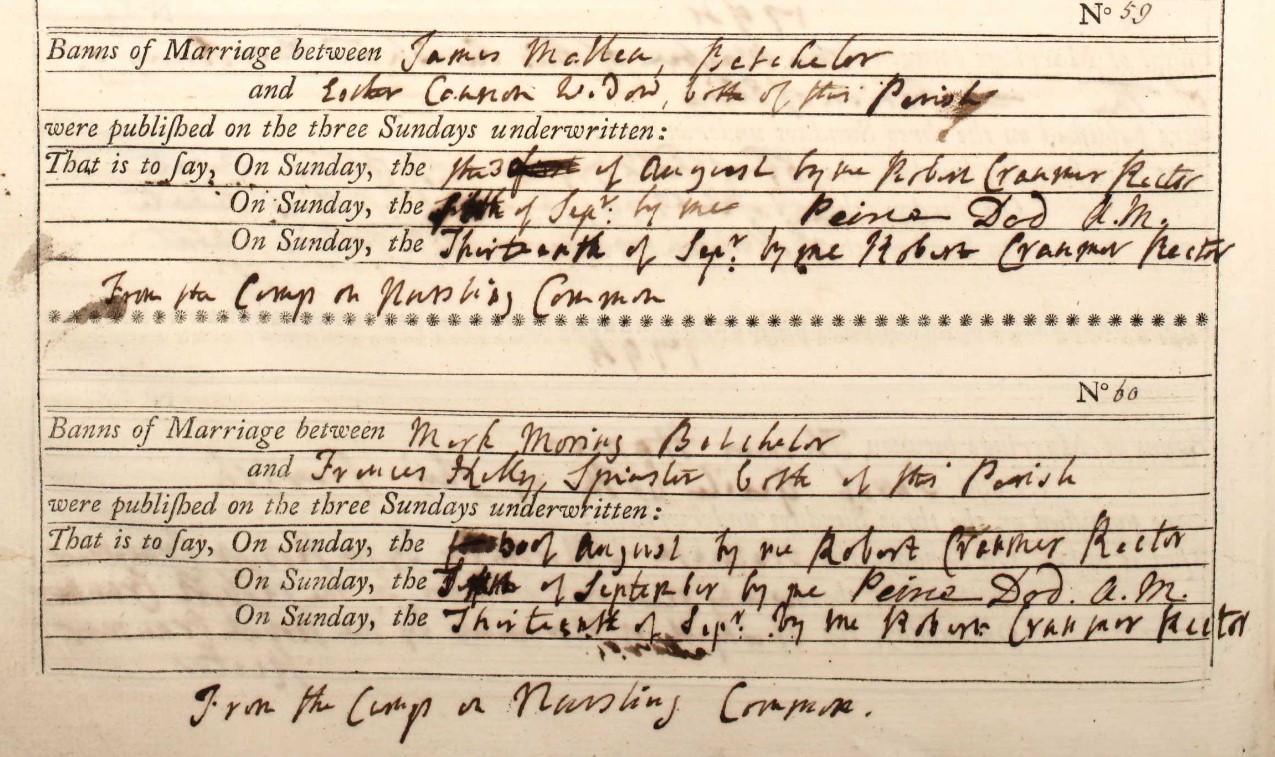
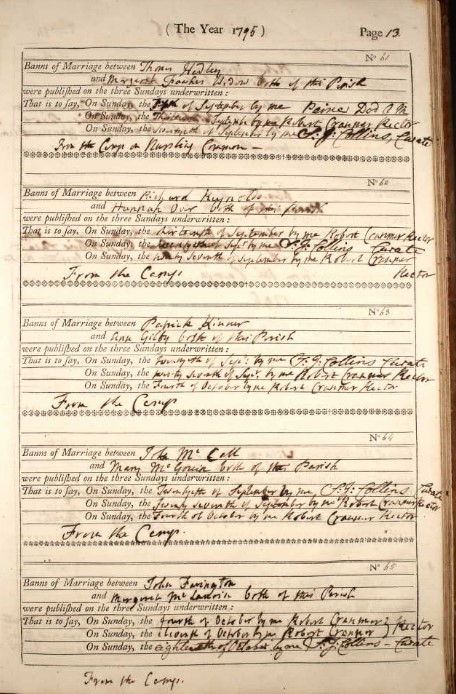
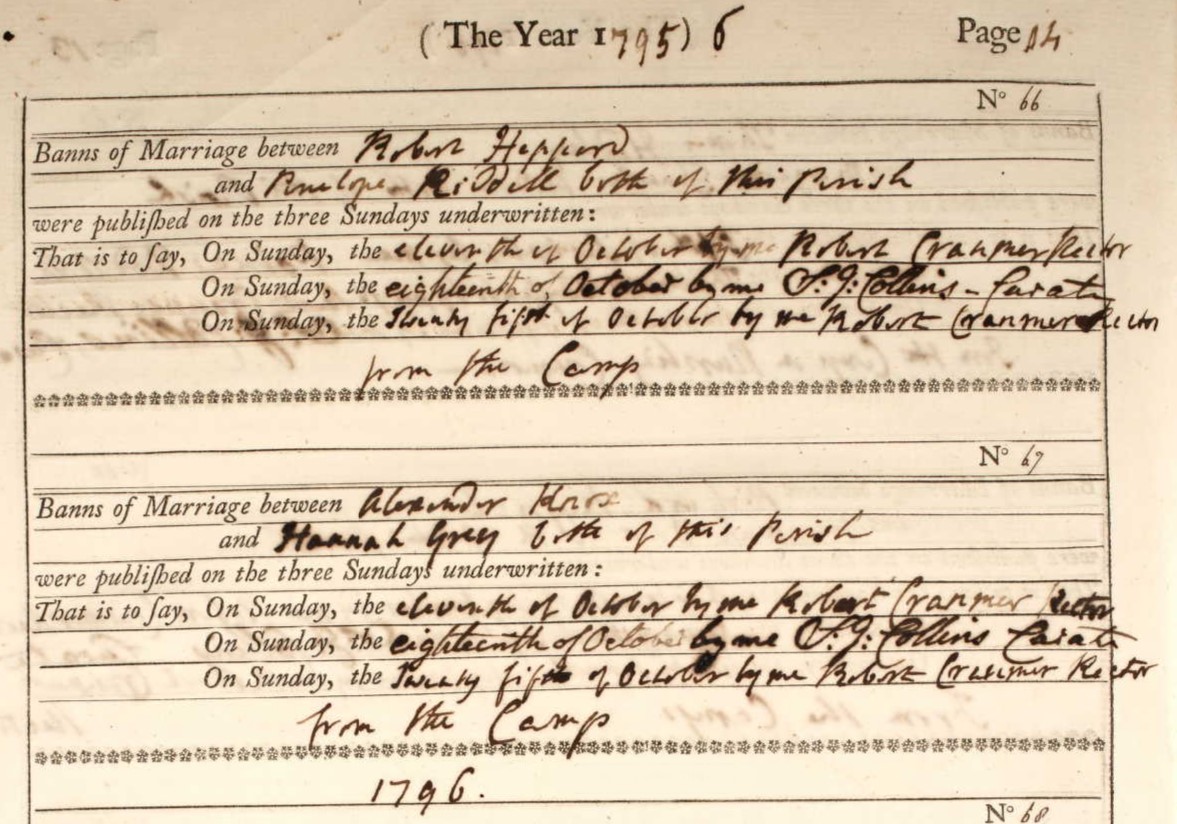
Note the further confirmation that the Camp is on Nursling Common.
There are nine sets of reading the Banns on the three pages above, but only six marriages by Banns in the Data above.
The following couples appear not to have made it into my Marriages data section
Thomas Hedley and Margaret Fawkes
Richard Reynolds and Hannah Over
Patrick Kinner and Ann Gilby
I will do some more research into these couples.
The Camp - The Great Push
The questions are all resolved thanks to two chapters in Soldiers, sugar, and seapower : the British expeditions to the West Indies and the war against revolutionary France by Duffy, Michael.
I am no longer looking for a small camp somewhere on Nursling Common. It was a vast undertaking, perhaps taking a significant part of the whole common.
I will precis the history gained from Chapters 7 and 8, together with other sources.
Industrial Revolution - 1750
Agricultural Revolution - 1670 - 1770
Canals - 1750 - 1900
Background - The Second Hundred Years' War. Perhaps the the First World War, with the Great War, 1914- 1918 being the second.
The Second Hundred Years' War is a periodization or historical era term used by some historians to describe the series of military conflicts around the globe between Great Britain and France that occurred from about 1689 (or some say 1714) to 1815, including several separate wars such as the Nine Years' War, the War of the Spanish Succession, the War of the Austrian Succession, the Seven Years' War, the American Revolutionary War and the French Revolutionary and Napoleonic Wars. The Second Hundred Years' War is named after the Hundred Years' War, which occurred in the 14th and 15th century. The term appears to have been coined by J. R. Seeley in his influential work The Expansion of England (1883).
The series of wars began with the accession of the Dutch William III as King of England in the Revolution of 1688. The Stuarts had sought friendly terms with Louis XIV: James I and Charles I, both Protestants, had avoided involvement as much as possible in the Thirty Years' War, while Charles II and the Catholic convert James II had even actively supported Louis XIV in his War against the Dutch Republic. William III, however, sought to oppose Louis XIV's Catholic regime and styled himself as a Protestant champion. Tensions continued in the following decades, during which France protected and supported Jacobites who sought to overthrow the later Stuarts and, after 1715, the Hanoverians. The principal Anglo-French conflicts in this time period were the Nine Years' War and the War of Spanish Succession. The war of Spanish Succession saw Britain begin its ascendancy as a commercial and naval power, but after the Peace of Utrecht, the two formed an Anglo-French alliance, their interests converging as they wished to prevent the rise of Spanish or Russian power. The alliance soon fell apart, and the two countries soon became bitter rivals once again.
After William III, the rivalry between the two countries shifted from being primarily about religion to being primarily about trade, colonies, and maintaining a balance of power. The primary conflicts in this time period between Britain and France were, in order: The War of the Austrian Succession, The Carnatic Wars, The Seven Years' War, and the American Revolutionary War. By the end of the Seven Years war, Britain decisively overtook France as Europe's greatest power, destroying French colonial power in India and North America. Yet France took advantage of American Revolutionary War to undermine British colonial hegemony in North America by supporting the rebellious colonists with both men and material, but debts from that conflict in turn sowed the economic seeds of France's own revolution shortly thereafter.
The Seven Years' War (1756–1763) was a global conflict involving most of the European great powers, fought primarily in Europe and the Americas. One of the opposing alliances was led by Great Britain and Prussia. The other alliance was led by France and Austria, backed by Spain, Saxony, Sweden, and Russia. The French and Indian War (1754–1763), the Anglo-Spanish War (1762–1763), and the Spanish–Portuguese War (1762–1763) were all parts of the Seven Years' War.
The War of the Austrian Succession ended in 1748, but failed to resolve ongoing tensions between the European powers. Continuing colonial disputes between Britain and France in North America resulted in the outbreak of the French and Indian War in 1754. Following the realignment of traditional alliances in the so-called 1756 Diplomatic Revolution, Prussia allied with Britain, while the long running French–Habsburg rivalry ended when Austria signed a treaty with France.
Spain entered the war on the French side in 1762, unsuccessfully attempting to invade Britain's ally Portugal in what became known as the Fantastic War. Spain lost Havana in Cuba and Manila in the Philippines to Britain, but they were returned in the 1763 Treaty of Paris.
In Europe, the large-scale conflict that drew in most of the European powers was centred on the desire of Austria to recover Silesia from Prussia. The Treaty of Hubertusburg ended the war between Saxony, Austria, and Prussia in 1763. France's supremacy in Europe was halted, while Prussia confirmed its status as a great power, challenging Austria for dominance within the Holy Roman Empire, thus altering the European balance of power.
The Anglo-French War, also known as the War of 1778 or the Bourbon War in Britain, was a military conflict fought between France and Great Britain, sometimes with their respective allies, between 1778 and 1783. As a consequence, Great Britain was forced to divert resources used to fight the American War of Independence (the rebellion by the Thirteen Colonies in North America) to theatres in Europe, India, and the West Indies, and to rely on what turned out to be the chimera of Loyalist support in its North American operations. From 1778 to 1783, with or without their allies, France and Britain fought over dominance in the English Channel, the Mediterranean, the Indian Ocean and the Caribbean.
Within days of the news of Burgoyne's surrender reaching France, King Louis XVI decided to enter into negotiations with the Americans that resulted in a formal Franco-American alliance and the French entry into the war, moving the conflict onto a global stage. Spain did not enter into the war until 1779, as an ally of France pursuant to the secret Treaty of Aranjuez. Vergennes' diplomatic moves following the French war with Britain also had material impact on the later entry of the Dutch Republic into the war, and declarations of neutrality on the part of other important geopolitical players like Russia.[9] Opposition to the costly war was increasing, and in June 1780 contributed to disturbances in London known as the "Gordon Riots".
At the same time France assisted the Spanish in operations against British-held Menorca and Gibraltar as well as islands in the Caribbean. Menorca was taken in 1781 as were many islands in the Caribbean. The Franco-Spanish alliance, however, in 1782 encountered severe setbacks with the defeat and capture of De Grasse at the Battle of the Saintes in April as well as the failure of the Great Siege of Gibraltar in September. France, also facing financial difficulties, wanted peace which meant coercing her Spanish ally into negotiations.
In addition, a series of naval battles between Admirals Edward Hughes and Pierre André de Suffren were fought in a French attempt to displace Britain from her Indian territories. The fighting here was largely inconclusive but the French were unable to displace the British and fighting only ended upon learning of the provisional Anglo-French-Spanish peace treaties of 1783.
The Bourbon War helped secure American independence and bring an end to the First British Empire but turned out to be detrimental to the French crown. The cost of participation in the American war inexorably led to France's own bankruptcy six years later, setting the stage for the French Revolution.
The American Revolutionary War (April 19, 1775 – September 3, 1783)
The conflict was fought in North America, the Caribbean, and the Atlantic Ocean. The war ended with the Treaty of Paris (1783), which resulted in Great Britain ultimately recognizing the independence.
After the British Empire gained dominance in North America with victory over the French in the Seven Years' War in 1763, tensions and disputes arose between Great Britain and the Thirteen Colonies over a variety of issues, including the Stamp and Townshend Acts. The resulting British military occupation led to the Boston Massacre in 1770. Among further tensions, the British Parliament imposed the Intolerable Acts in mid-1774. A British attempt to disarm the Americans and the resulting Battles of Lexington and Concord in April 1775 ignited the war. In June, the Second Continental Congress formalized Patriot militias into the Continental Army and appointed Washington its commander-in-chief. The British Parliament declared the colonies to be in a state of rebellion in August 1775. The stakes of the war were formalized with passage of the Lee Resolution by the Congress in Philadelphia on July 2, 1776, and the unanimous ratification of the Declaration of Independence on July 4, 1776.
The outbreak of the French Revolutionary Wars led to a renewed period of conflict between Britain and France, the latter now under the control of a republican government. The British led a pan-European coalition which opposed the French in the wars of the first, second, third, fourth, fifth and sixth coalitions. Despite Britain's allies in the Coalition suffering repeated defeats at French hands, British naval successes against the French, which deprived France of large parts of the French colonial empire, helped ensure the continued existence of further coalitions during the Napoleonic Wars. The final defeat of Napoleon in the Battle of Waterloo led to his abdication and exile, and effectively ended the recurrent conflict between France and Britain, with Britain decisively affirming its naval, imperial, and colonial supremacy over France for the foreseeable future. The British goal of restoring the French monarchy was confirmed by the Treaty of Paris and the subsequent Congress of Vienna.
After the end of the French Revolutionary and Napoleonic Wars, direct conflict between France and Britain came to an end, as both countries focused on expanding their colonial empires and consolidating influence in their respective spheres of influence. The two nations fought on the same side in the Greek War of Independence and the Crimean War, reflecting an increasing level of alignment in British and French foreign policies concerning Europe. During the fin de siècle period, growing levels of fear in both nations over the growing power of the German Empire (which was established in 1871 as a result of the Franco-Prussian War) led to the Entente Cordiale, a rapprochement in Anglo-French relations marked by a series of agreements signed on 8 April 1904. The Entente Cordial also resolved colonial disputes between Britain and France, and marked the definitive end of almost a thousand years of intermittent conflict, and replaced the modus vivendi that had existed since the end of the Napoleonic Wars in 1815 with a more formal agreement.
We have moved to far forward in time, but it was good to see how it ended. The Entente Cordial has lasted for a long time.
Moving back to the period under review.
The French Revolution was a period of political and societal change in France that began with the Estates General of 1789, and ended with the coup of 18 Brumaire in November 1799 and the formation of the French Consulate. Many of its ideas are considered fundamental principles of liberal democracy, while its values and institutions remain central to modern French political discourse.
The causes of the revolution were a combination of social, political, and economic factors which the ancien régime ("old regime") proved unable to manage. A financial crisis and widespread social distress led to the convocation of the Estates General in May 1789, its first meeting since 1614. The representatives of the Third Estate broke away, and re-constituted themselves as a National Assembly in June. The Storming of the Bastille in Paris on 14 July was followed by a series of radical measures by the Assembly, among them the abolition of feudalism, state control over the Catholic Church, and a declaration of rights. The next three years were dominated by the struggle for political control, and military defeats following the outbreak of the French Revolutionary Wars in April 1792 led to an insurrection on 10 August. The monarchy was replaced by the French First Republic in September, and Louis XVI was executed in January 1793.
After another revolt in June 1793, the constitution was suspended, and adequate political power passed from the National Convention to the Committee of Public Safety, led by the Jacobins. About 16,000 people were executed in what was later referred to as Reign of Terror, which ended in July 1794. Weakened by external threats and internal opposition, the Republic was replaced in 1795 by the Directory, and four years later, in 1799, the Consulate seized power in a military coup led by Napoleon Bonaparte on 9 November. This event is generally seen as marking the end of the Revolutionary period.
...
France primarily funded the Anglo-French War of 1778–1783 through loans. Following the peace, the monarchy borrowed heavily, culminating in a debt crisis. By 1788, half of state revenue was required to service its debt. In 1786, the French finance minister, Calonne, proposed a package of reforms including a universal land tax, the abolition of grain controls and internal tariffs, and new provincial assemblies appointed by the king. The new taxes, however, were rejected, first by a hand-picked Assembly of Notables dominated by the nobility, then by the parlements when submitted by Calonne's successor Brienne. The notables and parlements argued that the proposed taxes could only be approved by an Estates-General, a representative body that had last met in 1614.
Britain, as well as other countries, were immensely concerned with the risk of similar discontent and revolution spreading to other countries, including crossing the English Channel and destabilising the Government, and possibly deposing the monarchy.
Such fear resulted in some questionably decisions and actions.
The French Revolutionary Wars were a series of sweeping military conflicts resulting from the French Revolution that lasted from 1792 until 1802. They pitted France against Great Britain, Austria, Prussia, Russia, and several other countries.
The wars are divided into two periods: the War of the First Coalition (1792–1797) and the War of the Second Coalition (1798–1802). Initially confined to Europe, the fighting gradually assumed a global dimension. After a decade of constant warfare and aggressive diplomacy, France had conquered territories in the Italian Peninsula, the Low Countries, and the Rhineland due to its very large and powerful military, which had been totally mobilized for war against most of Europe with mass conscription of the vast French population. French success in these conflicts ensured military occupation and the spread of revolutionary principles over much of Europe.
As early as 1791, the other monarchies of Europe looked with outrage at the revolution and its upheavals; and they considered whether they should intervene, either in support of King Louis XVI, to prevent the spread of revolution, or to take advantage of the chaos in France. Austria stationed significant troops on its French border and together with Prussia, issued the Declaration of Pillnitz, which threatened severe consequences should anything happen to King Louis XVI and Queen Marie Antoinette. After Austria refused to recall its troops from the French border and to back down on the perceived threat of using force, France declared war on Austria and Prussia in the spring of 1792; both countries responded with a coordinated invasion that was eventually turned back at the Battle of Valmy in September. This victory emboldened the National Convention to abolish the monarchy. A series of victories by the new French armies abruptly ended with defeat at Neerwinden in the spring of 1793. The French suffered additional defeats in the remainder of the year and these difficult times allowed the Jacobins to rise to power and impose the Reign of Terror to unify the nation.
In 1794, the situation improved dramatically for the French as huge victories at Fleurus against the Austrians and Dutch and at the Black Mountain against the Spanish signaled the start of a new stage in the wars. By 1795, the French had captured the Austrian Netherlands and the Dutch Republic. The French also put Spain and Prussia out of the war with the Peace of Basel. A hitherto unknown general named Napoleon Bonaparte began his first campaign in Italy in April 1796. In less than a year, French armies under Napoleon destroyed the Habsburg forces and evicted them from the Italian peninsula, winning almost every battle and capturing 150,000 prisoners. With French forces marching toward Vienna, the Austrians sued for peace and agreed to the Treaty of Campo Formio, ending the First Coalition against the Republic.
The French Revolution and War with France.
In 1793, during the French Revolution, France declared war on Britain, Spain, Russia, the Holy Roman Empire, most of Italy, and The United Provinces. The conflict lasted for twenty-two years, with a series of victories by the French armies followed by defeats, leading to the rise of the Jacobins and the Reign of Terror.
Britain, France, Spain, Dutch, all had interests around the world. The stakes were immense. Letting France have its own way was not conscionable.
Spain and Portugal entered the anti-French coalition in January 1793. Britain began military preparations in late 1792 and declared that war was inevitable unless France gave up its conquests, notwithstanding French assurances they would not attack Holland or annex the Low Countries. Britain expelled the French ambassador following the execution of Louis XVI and on 1 February, France responded by declaring war on Great Britain and the Dutch Republic.
France drafted hundreds of thousands of men, beginning a policy of using mass conscription to deploy more of its manpower than the autocratic states could manage to do (first stage, with a decree of 24 February 1793 ordering the draft of 300,000 men, followed by the general mobilization of all the young men able to be drafted, through the famous decree of 23 August 1793). Nonetheless, the Coalition allies launched a determined drive to invade France during the Flanders Campaign.
France suffered severe reverses at first. They were driven out of the Austrian Netherlands, and serious revolts flared in the west and south of France. One of these, at Toulon, was the first serious taste of action for an unknown young artillery officer Napoleon Bonaparte. He contributed to the siege of the city and its harbour by planning an effective assault with well-placed artillery batteries raining projectiles down on rebel positions. This performance helped make his reputation as a capable tactician, and it fueled his meteoric rise to military and political power.
By the end of the year, large new armies had turned back foreign invaders, and the Reign of Terror, a fierce policy of repression, had suppressed internal revolts. The French military was in the ascendant. Lazare Carnot, a scientist and prominent member of the Committee of Public Safety, organized the fourteen armies of the Republic, and was then nicknamed the Organizer of the Victory.
The year 1794 brought increased success to the French armies. On the Alpine frontier, there was little change, with the French invasion of Piedmont failing. On the Spanish border, the French under General Dugommier rallied from their defensive positions at Bayonne and Perpignan, driving the Spanish out of Roussillon and invading Catalonia. Dugommier was killed in the Battle of the Black Mountain in November.
On the northern front in the Flanders Campaign, the Austrians and French both prepared offensives in Belgium, with the Austrians besieging Landrecies and advancing towards Mons and Maubeuge. The French prepared an offensive on multiple fronts, with two armies in Flanders under Pichegru and Moreau, and Jourdan attacking from the German border. The French withstood several damaging but inconclusive actions before regaining the initiative at the battles of Tourcoing and Fleurus in June. The French armies drove the Austrians, British, and Dutch beyond the Rhine, occupying Belgium, the Rhineland, and the south of the Netherlands.
On the middle Rhine front in July, General Michaud's Army of the Rhine attempted two offensives in July in the Vosges, the second of which was successful but not followed up, allowing for a Prussian counter-attack in September. Otherwise this sector of the front was largely quiet over the course of the year.
At sea, the French Atlantic Fleet succeeded in holding off a British attempt to interdict a vital cereal convoy from the United States on the Glorious First of June, though at the cost of one quarter of its strength. In the Caribbean, the British fleet landed in Martinique in February, taking the whole island by 24 March and holding it until the Treaty of Amiens, and in Guadeloupe in April, where they captured the island briefly but were driven out by Victor Hugues later in the year. In the Mediterranean, following the British evacuation of Toulon, the Corsican leader Pasquale Paoli agreed with admiral Samuel Hood to place Corsica under British protection in return for assistance capturing French garrisons at Saint-Florent, Bastia, and Calvi, creating the short-lived Anglo-Corsican Kingdom.
By the end of the year French armies had won victories on all fronts, and as the year closed they began advancing into the Netherlands.
The year [1795] opened with French forces in the process of attacking the Dutch Republic in the middle of winter. The Dutch people rallied to the French call and started the Batavian Revolution. City after city was occupied by the French. The Dutch fleet was captured, and the stadtholder William V fled to be replaced by a popular Batavian Republic, a sister republic which supported the revolutionary cause and signed a treaty with the French, ceding the territories of North Brabant and Maastricht to France on 16 May.
With the Netherlands falling, Prussia also decided to leave the coalition, signing the Peace of Basel on 6 April, ceding the west bank of the Rhine to France. This freed Prussia to finish the Third Partition of Poland.
The French army in Spain advanced in Catalonia while taking Bilbao and Vitoria and marching toward Castile. By 10 July, Spain also decided to make peace, recognizing the revolutionary government and ceding the territory of Santo Domingo, but returning to the pre-war borders in Europe. This left the armies on the Pyrenees free to march east and reinforce the armies on the Alps, and the combined army overran Piedmont.
Meanwhile, in Africa and Asia, the Dutch Cape Colony and Ceylon were invaded by the British.
Meanwhile, Britain's attempt to reinforce the rebels in the Vendée by landing troops at Quiberon failed, and a conspiracy to overthrow the republican government from within ended when Napoleon Bonaparte's garrison used cannon to fire grapeshot into the attacking mob (which led to the establishment of the Directory).
On the Rhine frontier, General Pichegru, negotiating with the exiled Royalists, betrayed his army and forced the evacuation of Mannheim and the failure of the siege of Mainz by Jourdan. This was a moderate setback to the position of the French.
In northern Italy, victory at the Battle of Loano in November gave France access to the Italian peninsula.
I think that is enough of Wikipedia. Great information, which provides the backdrop to Nursling Camp. France were walking through Europe and Britain was not able to stop them.
Some of the troops form Nursling Camp were involved in the attempt to reinforce the rebels in the Vendée by landing troops at Quiberon, but that initiative failed.
Britain could not win the land war in Europe, but it could hurt the French interests around the world, and hamper trade with France.
Soldiers, sugar, and seapower : the British expeditions to the West Indies and the war against revolutionary France by Duffy, Michael.
Chapter 7 - 'The Great Push'
'A complete success in the West Indies is essential to the interests ... of this country': the origins of the 'great push'
By mid-February 1795 it was at last clear to the Secretary of State for War that he would not secure his Caribbean objectives during the 1794-5 campaigning season. On the 13th, Dundas told his colleague, the Duke of Portland, that the reinforcement then on its way would arrive too late for much active exertion and must be spread out to defend British possessions. Instead, the must look to the autumn to reconquer Guadeloupe, for which 'a commanding force' would be needed, and likewise, if Saint-Domingue had not been evacuated by then, they would require ' a very powerful force' to ensure its undisturbed possession. In this lay the germ of the 'great push', ...
By the autumn the operation had developed into the biggest overseas expedition ever mounted from Britain. ...
In short, the only way to stop the revolutionary effect of the French doctrines in the Caribbean was to oust the French completely from the area, and since they seemed to have gained control of the Dutch West Indian possessions these, too, would have to be taken. ...
The full meaning of this was finally revealed on 23 July when Dundas alerted the Transport Board that it would shortly have to find shipping for an expedition of 25,000-30,000 men to the Caribbean. ...
July saw the failure of the only other alternative, a landing in support of the royalists on the west coast of France, and this was followed by news that Spain, too, had made peace.
Further news that the Spanish had ceded their colony of Santo Domingo to the French as part of the peace terms added to the pressure. Santo Domingo was larger and potentially much more fruitful that French Saint-Domingue. If France could secure its possession, it would facilitate the recovery of its own colony and threaten to overthrow the whole political, military, and commercial balance of the Caribbean.
The Cabinet recommendation which Dundas forwarded to the King next day was for 15,000 'effective' infantry to be sent to the Windward and leeward Islands to take Guadeloupe and St Lucia, 'not only from their own intrinsic value, but as being essential to the preservation of his Majesty's other colonies', and for 12,000 more 'effective' infantry to be sent to conquer the whole island of St Domingo, French and Spanish. According to a planter close to the ministers, Spanish Santo Domingo would then be offered to the emigre French royalists to be an independent settlement under British protection. Royal approval on 16 August set the seal on this 'great push' in the Caribbean.
By 'effective' infantry the Secretary for War meant musket-carrying rank and file, so that adding the normal proportion of one-eighth more for NCOs and officers, the force would be over 30,000 strong, exclusive of the artillery and cavalry which would be further added.
... and 4,000 more ordered to the French coast in early August, there were thus considerably less that 20,000 troops available for the expedition, ...
Gradually the expedition was assembled at camps at Nursling and Netley near Southampton and on Spike Island in the Cove of Cork. Summer 1795 saw most of the British regular army in movement to one or the other of those destinations. Of the twenty-three regiments allocated to the Windward and Leeward Islands contingent, seven (the 14th, 19th, 27th, 28, 33rd, 42nd, 57th) were already encamped at Southampton. They were to be joined by five more from the north-eastern district (8th, 37th, 44th, 55th, 58th); four more from the Norfolk garrison (3rd, 38th, 53rd, 88th), marching down to Tilbury to be shipped to Southampton: the 63rd came from Yarmouth: three came from the Channel Islands(2nd battalion 2nd, 92nd from Guernsey 2/29th from Jersey, and three from Plymouth (2/25th, 31st, 48th). To Southampton also came units to be drafted to make up the expedition's numbers. Three were already there (101st, 103rd, 109th) and a fourth (117th) was 'found' by Abercromby in the New Forest; the 94th came from Guernsey; and others came from as far as Leith in Scotland ('Pringle's regiment'), South Shields (115th), the Isle of Man (the 'Dublin regiment'), and Dublin (the Scottish 116th regiment to be drafted into the 42nd 'Black Watch'). Some units had already been drafted into the expedition's regiments before the latter embarked for Southampton -- the 114th and 133rd into the Norfolk contingents, for example.
Some of these regiments were on the move in early August, but it was not until final Cabinet approval of the expedition was given that, on the 15th, the Transport Board was ordered to provide shipping to concentrate the bulk of them. At that time it was Dundas's intention that Abercromby's force should be assembled and ready to embark at Southampton by 15 September. But to move so many men such long distances from so many directions took longer than anticipated.
In the event Abercromby's force sailed with 15,114 effective infantry - over 800 short of Dundas's final figure ...
Yet the expedition did constitute a considerable record of achivement, as its apoligists haened to point out. If it proved inpossible to send 30,000 men at one time, nevertheless the 18,742 officers and men who sailed with Abercromby on 16 November were still the largst single long-distance overseas expedition to depart from British shores, and it sailed earlier that Grey and earlier than any other expedition sent from Britain to the West Indies in the two previous wars. Moreover, an enormous effort had been put into making it the best-equiped expedition to leave Britain.
Just a very short extract from Chapter 8 'Christian's Gales'
The great storm of 17-18 November
As the delays in the expedition mounted, so Dundas became more and more impatient. Abercromby's vast camp on Nursling Common -- 'the largest of Regulars ever known in the country' -- was becoming an embarrassment. In a tear of national food scarcity a new town of 15,000 population had suddenly been planted on the south coast -- at a time when there were less than fifty towns in England and Wales with over 10,000 population -- and in an area already heavily committed to supplying the fleet. The strain on local supply was enormous and very costly.
The arrival of the bulk of the transports at Portsmouth on 20 October sent the admiral [Christian] to Nursling to arrange the embarkation of the expedition with the army. One brigade was already afloat in the abortive advanced convoy of the Commerce de Marseilles. Now two more were marched down to Gosport to embark on the East Indiamen at Stokes Bay, while the lighter West Indiamen saild up to Southampton to embark the remaining three infantry brigades and the cavalry.
The above extracts are just a small take from the very excellent
Soldiers, sugar, and seapower : the British expeditions to the West Indies and the war against revolutionary France by Duffy, Michael.
Without which I would most likely still be unawares of the reason for a spike in baptisms, marriages, and burials, recorded in the Nursling Parish Register. There is so much more in the book. It is worth reading in full. I have just extracted enough to fit with the Nursling Camp narrative, and provide an inkling to the scale of the camp and the endeavour. The book continues with how the campaign progressed, but I will not tell all here.
For comparison, the population of the nearby town of Southampton, in 1801 was 10,056 according to;-
GB Historical GIS / University of Portsmouth, Southampton UA through time | Population Statistics | Total Population, A Vision of Britain through Time.
URL: https://www.visionofbritain.org.uk/unit/10142611/cube/TOT_POP
Date accessed: 27th January 2025
That is how the Nursling Camp was emptied and returned to being Nursling Common. Such a mighty endeavour, but so little known.
Nursling Common played a small but significant, unsung part, in a great and important act of self preservation for Britain.
I suspect there is a similar spike in church activities in Netley, for Netley Camp. Which Netley though, Netley on the East of Southampton Water, or what is now Netley Marsh, to the west, in the Parish of Ealing.
About 12 miles between Nursling Camp and Netley, 41/2 hours walk, with Southampton in between, but to the south of the route crossing the River Itchen at Mansbridge, the lowest fixed crossing at the time. About 5 miles between Nursling Camp and Netley Marsh, 2 hours walk.
Searching the internet for Nursling Camp 1795;
The Bedwell Arms between Lordshill and Rownhams finally closed on December 31st. 1971. Locals gave it a rather crude name!
The site had a hospice in the 16th century. In 1795 an on site spring provided water for the Officers from the army transit camp on Nursling Common. The spring also supplied pure water to Southampton Eye Hospital.
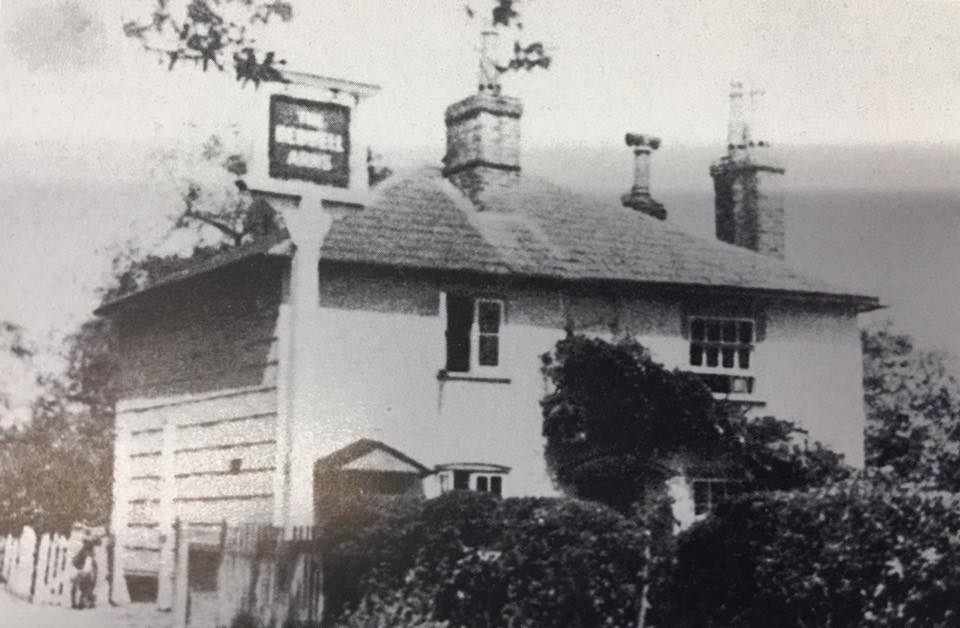
Together with the Facebook post
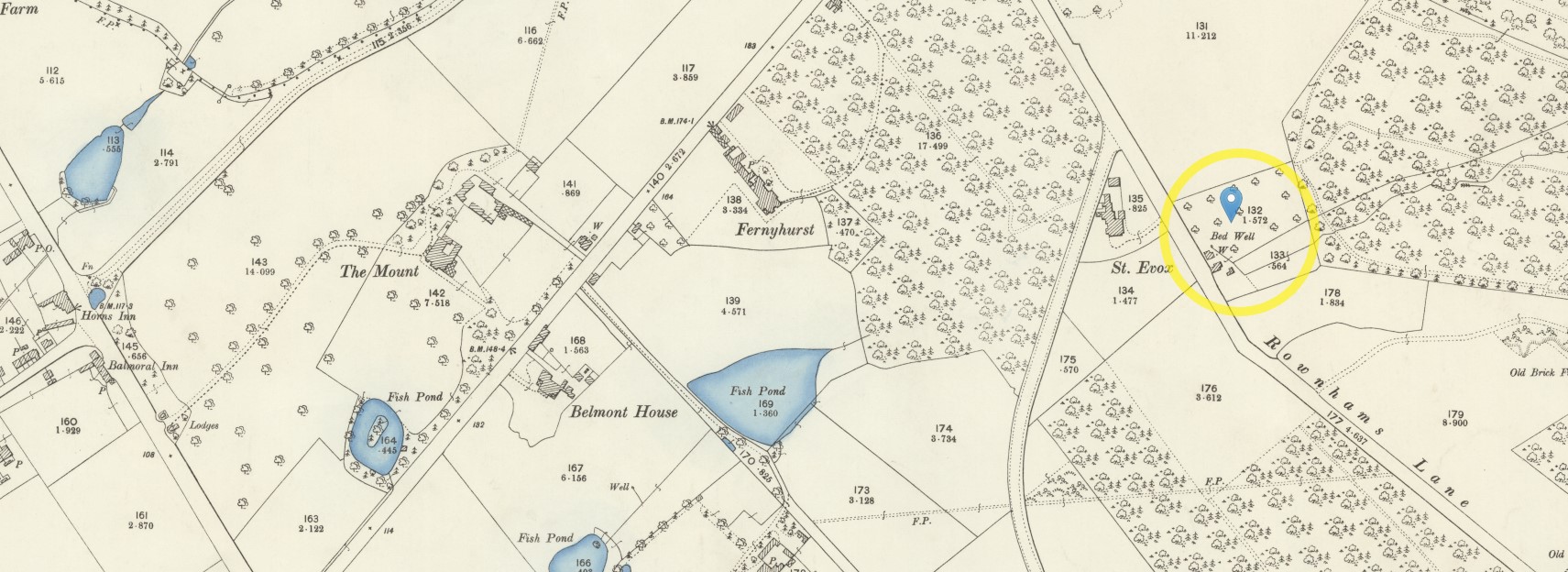 Bed Well: Possibly site of Bedwell Arms Rownhams on NLS Old OS 25" Map Hampshire and Isle of Wight LVII.13 Revised: 1895, Published: 1897
Bed Well: Possibly site of Bedwell Arms Rownhams on NLS Old OS 25" Map Hampshire and Isle of Wight LVII.13 Revised: 1895, Published: 1897
There is a well marked W, annotated Bed Well on the above map, near the junction of Rownhams Lane and Bakers Drove. This could be the location of the Bedwell Arms Public House mentioned in the Facebook posts. Therefore, the site of the source of water for the soldiers of the Nursling Camp in 1795.
Ordnance Survey, 1:25,000 maps of Great Britain -- OS Map SU 31 Sheet 41/31 - B - Publication date: Revised: 1907 to 1947, Published: 1951
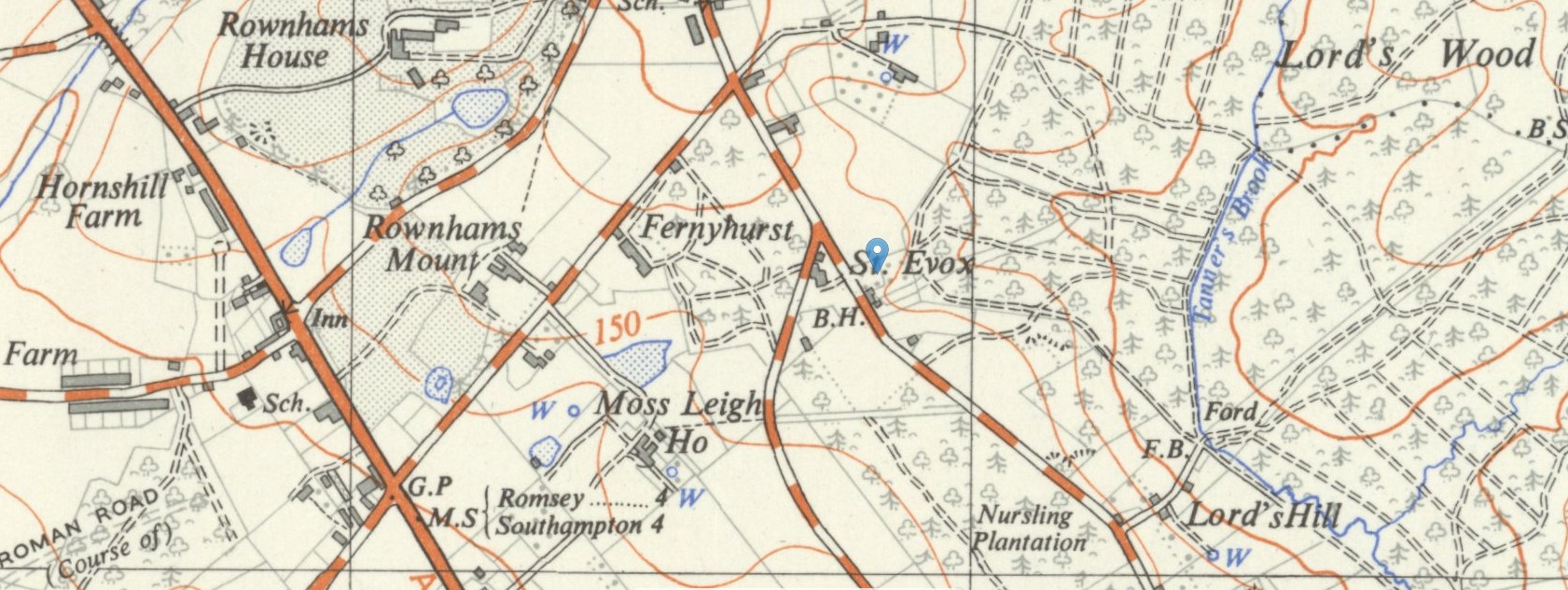 Ordnance Survey, 1:25,000 maps of Great Britain -- NLS Old OS Map SU 31; Sheet 41/31 - B - Publication date: Revised: 1907 to 1947, Published: 1951 -- Bed Well - Bedwell Arms Rownhams
Ordnance Survey, 1:25,000 maps of Great Britain -- NLS Old OS Map SU 31; Sheet 41/31 - B - Publication date: Revised: 1907 to 1947, Published: 1951 -- Bed Well - Bedwell Arms Rownhams
With the blue marker in the same place as the previous map, it appears that the same two buildings are shown adjacent to road, Rownhams Lane. The annotation B.H. represents Beer House. This is a stronger hint that it is the Bedwell Arms.
THE BRITISH ARMY AND THE CARIBBEAN EXPEDITIONS OF THE WAR AGAINST REVOLUTIONARY FRANCE 1793-1801
Michael Duffy










